#she has big nicole kidman energy
Text
realized I forgot my cat’s birthday (2 days ago) and I bet that’s why she’s being so standoffish; happy belates to my sweet baby lady Stevie Nicole Kidman Fajita, born on the day of (one of) her namesake(s); imbued with all the cryptic and obscure powers of the circumspect and self-reflective gemini, awash in magics both strange and familiar






3 notes
·
View notes
Photo

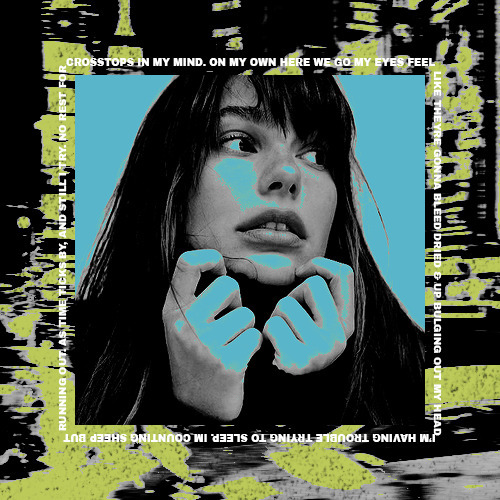
have you seen sunday wexler around long beach ? the twenty-five year old can be spotted at slide away during their free time. word around the city is that they’re insouciant and resilient yet, they can also be sardonic and reticent, but you didn’t hear that from me. they’re currently a valet at shoreline society club and have been in the city for seven years. when i think of them, i think of the pistoling sound of a firework as it sets off into the night sky — cloud of smoke blooming from the parking lot of an abandoned warehouse, sticker-covered skateboard decks shredding the rails of a church’s front steps, chasing a monster energy drink with a red bull in the name of unhinged self care. they’re typically seen walking the streets of long beach with the keys to some elitist scumbag’s car she took on a joyride.
introduction.
tw: parental death, implications of alcoholism and abuse.
pinterest ▪︎ spotify ▪︎ musings ▪︎ connections
“ i'd take a razor scooter to the ankle before i’d drink a spritzer. ”
hi besties ! ✌️😙✌️ i’m lauren ( 26, she + her, est ) i’m a pisces sun, leo moon, scorpio rising for the astrology pals out there, a v enthusiastic pinterest user, and a nicole kidman amc ad apologist ( heartbreak does feel good in a place like this ). i’m also a big musings / hc fan too, so if u ever wanna talk shit abt our muses at any and all hours i’m always down to clown 🤡 anyways ! i hope y'all like or despise >:) this menace to society, day of the week or sunday wexler who has had me by the throat for 5 years as of february … that is so crazy to me like WOAH. with tht being said, feel free to smash tht heart or hmu on d*sco anya taylor lacroix#0255 if u would like to plot <333
#90s.intro#AHHH <333 v excited 2 be here.#apologies 4 the novel of an intro 😭#also ik brain stew is from 1995 but this graphic was made 1000 yrs ago#nd i'm too lazy to fix it so we Move
7 notes
·
View notes
Text
The Stepford Wives (2004)

Wait, was Nicole Kidman doing some sort of future impression of Tom Cruise? Did she know something we didn’t? Joanna Eberhart’s television executive persona simply drips mid-00’s Cruise, from his infamous couch-jumping appearance on Oprah to that utterly bizarre Scientology speech. Fresh off their divorce, maybe Kidman was trying to warn us of things to come. Outside of the hubbub of Manhattan, Joanna is a fish out of water. But even moreso, Kidman is unmoored in Frank Oz’ picture. She is an actor capable of truly great performances. But as this film along with others during this period represent a very strange chapter in her career. The quasi-satirical mid-00s flick has a very specific energy, and this Stepford remake is the uncut heroin of that. We’re out of the 80s and 90s heyday of casual misogyny and homophobia, but we aren’t quite ready for full representation. Roger is still fop (not that this doesn’t make him any less of an absolute queen), and the radical notion that toxic masculinity is bad is presented like it’s a doctoral thesis. I suppose there is some introspection here—the idea that Claire Wellington doesn’t need to modify men to get them to do monstrous things to their wives and rob them of their autonomy has some bite to it—but by and large it reads like a low-effort play for brownie points that decides to lean way too far into references which date themselves practically the second they’re released. You could practically hear Paul Rudnick pat himself on the back over the AOL slow connection speed barb. All told, it’s fine, I guess. Bette Midler is fun. Nicole Kidman tries in some scenes. Roger Bart gets to make countless references.
THE RULES
SIP
Someone says ‘network’ or ‘woman’.
Any time Glenn Close doesn’t smile.
Someone says Joanna’s name.
Roger makes a reference.
Someone pushes a button on a remote.
BIG DRINK
Cameo by a famous person.
Someone says ‘pine cone’.
A clothing brand is named.
#drinking games#stepford wives#frank oz#nicole kidman#bette midler#glenn close#sci fi#sci fi & fantasy#comedy#satire
1 note
·
View note
Note
good morning my darling Minnie! new Seb interview dropped and here's a summary in case someone wants it:
- Lily had an interview prior him and said she and Sebastian became really good friends and spoke about how generous and brave Seb is as an actor ❤️
- Sebastian said he was filming a scene of adm when the nominations were announced and he said the first one to congratulate him was the director Aaron Schimberg, he gave him the news and then they just kept on filming 😂
- he was asked if he's still getting excited about working with great people, the interviewer mentioned Nicole Kidman and you know what this sunshine said? 🥺 he said he almost had a breakdown the other day while filming his current movie. no "big" names yet he's still so excited to work with Renate, Adam and everyone involved. his heart ❤️
- He spoke a lot with Jessica Chastain before/during p&t and she recommended him to wear an ear piece to listen to Tommy's voice all the time, he listened to music instead 😂
- he said he tried to eat once a day to lose weight but then he'd feel without energy
- he is literally so grateful for everything he's achieved and the people who've helped him in the way ❤️
- he said this could be the only time he ever gets an Emmy nomination and the interviewer said "no way" and Seb proceed to say that as an eastern European he was raised to no have expectations ever and his mother taught him to always look behind his back 💔
- he said for him it was really difficult the first years in America because he didn't speak English, he had an accent and couldn't communicate correctly with other people
- he said before this interview he was followed by paparazzis for an hour and a half and he was just circling around to basically not get home because he was scared to being followed 🙁 he then proceed to say he often tells to himself "Sebastian suck it up, you choose this profession" and the interviewer told him he's very generous because he shouldn't have to 😩 this man is way too kind i swear, incredible.
- he said that even though he went to college and he got his degree, hes never stopped studying. This guy has been constantly studying his whole life - and we can notice it, i hope he knows that!!
- he told again about how he was asked to get Chris to voice the penis in p&t and he said there was no way he was telling Chris about it because if he said yes "it would be too much for Chris and himself 👀"
- she asked about the penis scene and Seb said the show proves a point because that's the question he's been asked the most during the press of p&t
https://variety.com/2022/tv/awards/pam-tommy-lily-james-sebastian-stan-1235327825/
Good morning my love! Aaahhh THANK YOU for this summary, that's fantastic seeing as I probably won't have time to listen to the full thing (though I'll skip through it for sure and read the interview!) but I do very much want to know all the interesting things that were no doubt said!
Oh god, everything he said about his past, and the fact that he's still so unbelievably humble, and how hard working and dedicated he is, like we knew all this but he proves it time and time again and it's incredible 😭 But GOD, the thing about the paparazzis is so sad ugh, I can't believe it. That breaks my heart. Yeah, he did choose this profession, but he chose acting, not being hounded by photographers, wtf. I hate that, he deserves so much better :(( But he really is too kind and generous, such a good person, ugh.
And then the whole P&T Penis thing with Chris, it's just hilarious and cute and amazing, I love it so much. I was a little worried at first what he was going to say because I was like 'too much..?' but then I listened and it was like 'ooohhh, too much, I see...😏' This cutie!!! Sebastian honey, your crush is showing <33
Thank you so much again for this rundown, lovely! I really appreciate it, big kiss for you! 😘😘
46 notes
·
View notes
Text
The Northman
There was a bit of mother/son incest in The Northman that is probably worth talking about. This is going to get spoilery.

So The Northman is a retelling of a Viking legend that inspired Hamlet and The Lion King. The story is familiar: the main character, Amleth, is the son of a king. Amleth's father is murdered by his brother, Fjolnir, Amleth's uncle. Fjolnir then marries Amleth's mother, Gudrun, and assumes the throne, believing Amleth dead. Amleth escapes and swears revenge. (“I will avenge you, Father. I will save you, Mother. I will kill you, Fjolnir.” If you've seen the trailer you'll be familiar with that line.) This all takes place when he is a child, perhaps 10 or so. He is taken in and trained to be a Berserker, and sort of loses sight of his vengeance, until a spiritual experience reminds him of his destiny. (Alexander Skarsgard plays him as an adult, and Nicole Kidman plays Gudrun, his mother.)
Amleth goes undercover as a slave at his uncle's homestead. (Fjolnir no longer has his kingdom, which I won't get into.) Amleth finds out he has a brother, who is still a child. Amleth essentially haunts the place, killing her and there and creating an atmosphere of fear. He eventually has an opportunity to speak alone with his mother, and discovers that the situation is not at all what he thought: Gudrun was originally the slave of the king/Amleth's father and she never loved him. She loved Fjolnir, and urged/convinced Fjolnir to kill his brother, kill Amleth, and take the throne and her. Gudrun doesn't just tell Amleth this, she throws it in his face. It's a really ugly scene.
So then she tells him that if he kills Fjolnir that he'll be the king now and she will be his queen, or something very much to that effect. And she starts to come onto him.

Eventually building to her kissing him. He sort of resists but sort of kisses her back at the same time. He eventually pushes her away, but it's definitely not at first. And of course he's horrified by her and furious, he's mad enough to kill her and you can't really blame him for that. So you really have to wonder what it would have been like if she wasn't actually horrible and hadn't just told him all of those horrible things. (Plus he has a love interest that he loves very much.)
Presumably she was only manipulating him. She clearly doesn't love him as a mother and I don't think she would have been happy to go with him instead if he killed Fjolnir.
Later, Amleth who has been in hiding comes back and is ready to END THIS. I can't believe how fuzzy my memory is already, it has only been two weeks since I saw it, but anyway, I believe he has to kill his mother and his half-brother out of self-defense. He really doesn't want to do it, and when they're both dead he's clearly upset about it. (In an earlier scene he had saved his little brother's life.) He couldn't help but care about them.
(Now I'm imagining if it had been a sister instead, and she had been older. Cut Amleth's love interest. You got a good bro/sis story cooking here.)
In one of the first scenes, when Amleth is still a child, he runs to tell his mother that his father is returning and she's in the middle of being dressed and she's still naked. So that was interesting, particularly in light of what happens later.
Also, I totally forgot this until I was looking for pictures, but Nicole Kidman and Alexander Skarsgard played husband and wife in Big Little Lies. (But he was abusive, so that's not the most fun example of “incestuous casting”.)


This was a really good movie. Not for everyone, but I loved it. I had no idea there was going to be incest going, but a little ways into scene, I was like, “there's an energy here, it's going to get interesting”. The candlelight and everything. So I wasn't surprised when their faces got really close together, but he kissed her back more than I thought he was going to, though a lot of it was shock.
I don't know what's in the original legend, I haven't looked into it, but many interpret Hamlet as having some mother/son vibes, and a couple of movie versions and adaptions have been pretty suggestive. So there was already an oedipal presence here.
If it had been played without the “twist” (so to speak), and Amleth had rescued his desperately unhappy mother, and she had loved him and been so happy to see him alive, and a romance had developed there, that would have been great. But I'm also interested in this story where she had always been pretending and then he sees the real her and she's horrible but they're matched, in a way, and there's a sexual tension that he really wishes didn't exist but was there.
Anyway, there's some meat here to ponder on, but for the most part this is a fun bit of incest but not super shippable and I can't even really call it one-sided, it's no-sided but happened anyway? That's its own kind of unique.
Nicole Kidman kissed Alexander Skarsgard at the Emmys and there are a bunch of pictures of it.


Anon: I haven’t seen it yet but I’ve heard there’s an incest scene in the Northman(unfortunately I don’t know any other details sorry)
Thank you! I have been meaning to write about this for two weeks. I'm glad that even if I hadn't seen the movie, we would have heard about it.
#commentary#noiv#nr#introduction#first post#r: ms#canon#the northman#amleth and gudrun#hey they were a couple in that other thing
15 notes
·
View notes
Text

How Spanish cinema hit the big time

MADRID
With a Golden Bear for Spanish director Carla Simon and four compatriots nominated for Oscars, including superstars Javier Bardem and Penelope Cruz, Spanish cinema has now begun to captivate a global audience.

When Bardem and Cruz, who have been married for over a decade, were both tapped for Oscars, the 53-year-old actor could hardly contain his excitement.

"The fact that (Penelope's) nomination was for a role in Spanish... seems really extraordinary, even historic in terms of the Spanish brand," he said in February.

Unlike other countries with a long and distinguished history of cinema, Spain has struggled to establish itself on the international stage.
So far, Luis Bunuel has been the only Spanish director to win the coveted Palme D'Or at Cannes Film Festival for his provocative 1961 feature "Viridiana".
But all that is changing, with Spanish cinema increasingly recognized for its contribution to the silver screen, the most recent being Carla Simon's triumph at this year's Berlinale where she took the top prize for "Alcarras" (2022), a Catalan drama about peach farmers.
And according to Variety magazine, Cruz is rumored to be in the running for president of the jury at Cannes, an honor already bestowed upon the legendary Pedro Almodovar, by far Spain's best-known filmmaker.
Cruz herself is the only Spanish actress ever to win an Oscar, taking home the gong in 2009 for best supporting actress in the Woody Allen comedy "Vicky Cristina Barcelona".
And if she wins best actress at the Oscars later this month for Almodovar's "Parallel Mothers", it will be a coup for a film entirely "Made in Spain", whose soundtrack has also been nominated for best original score.
The score was written by Basque composer Alberto Iglesias, who has worked with Almodovar for two decades on 13 of his films. This is the fourth time an Iglesias soundtrack has been nominated for an Oscar.
For him, there is "strong momentum" within Spanish cinema.
"There is an energy... it has to do with the film schools that have been working for a long time to create new filmmakers," he told AFP.
"It has been really difficult for Spanish cinema to cross the threshold and get into these big international festivals," explains Pilar Martinez-Vasseur, director of the Spanish Film Festival in the French city of Nantes.
Spanish films which have received acclaim abroad are often not identified as such, she said, pointing to the 2001 psychological thriller "The Others" starring Nicole Kidman which was directed by Spain's Alejandro Amenabar.
"In Spain, we still have the idea that Spanish cinema is bad, that it's a nest of communists, that filmmakers are pampered, they do nothing and get subsidies," she said, calling for greater support from the government.
Filmmaking in Spain receives far less state aid than in France, experts say.
Spanish cinema has had to "learn how to break into a globalised ecosystem," said Beatriz Navas who heads the Institute of Cinematography and Audiovisual Arts (ICAA), which is subsidized by the culture ministry.
"This hasn't happened overnight because you need some sort of 'greenhouse' environment where filmmakers can work with freedom," she told AFP. "And the 'incubation time' needs to be sufficient for these productions to achieve the recognition and prestige they deserve."
As well as Cruz, Bardem and Iglesias, Spain also has a fourth horse in the Oscar race in the shape of Alberto Mielgo's "The Windshield Wiper" which has been nominated for best animated short film.
"This is the best moment for Spanish cinema," said Jose Luis Rebordinos, director of the prestigious San Sebastian film festival.
"We are making a lot of cinema and audiovisual productions in Spain, as well as for streaming platforms which is bringing a lot of work so Spanish film technicians are getting better and better," he said.
Spain's Western-friendly landscapes have drawn Hollywood directors since the 1960s and is becoming an increasingly popular destination for filming series -- Netflix, which set up its first European studios in Madrid in 2019, scored huge hits with "Money Heist" and "Elite".
Last year, the government said it wanted Spain to become Europe's "audiovisual hub", pledging to inject 1.6 billion euros to expand the film and TV production sector by 30 percent by 2025.
"International critics are increasingly focusing on our cinematic output thanks to figures like Almodovar, Javier Bardem and Penelope Cruz," said Rebordinos. "They are finding ways to draw more attention to Spanish cinema."
2 notes
·
View notes
Photo
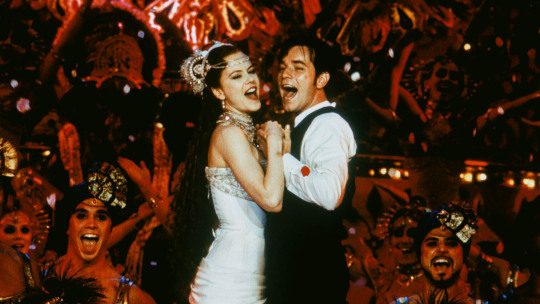
Spectacular Spectacular!
On the twentieth anniversary of its explosion onto big screens, Ella Kemp high-kicks into the Moulin Rouge! once again, accompanied by screenwriter Craig Pearce and a chorus line of jukebox-musical academics and swoony Letterboxd fans.
“You’re always writing for yourself, for the film you want to see. I like all kinds of different films and I think teenage girls do too.” —Craig Pearce, Moulin Rouge! co-writer
This is a story about love. A love born at the turn of the twentieth century in an iconic Parisian cabaret and brought to life in 2001 on Australia’s most spectacular sound stage. A valentine to excess, greed, fantasy and, above all, to the fundamental Bohemian ideals: truth, beauty, freedom and love. This is the story of Moulin Rouge! and how it still burns bright, two decades on, in the hearts of romantics all over the world.
The film, a fateful love story between penniless writer Christian and dazzling courtesan Satine—played by Ewan McGregor and Nicole Kidman—premiered at the Cannes Film Festival on May 9, 2001 and opened in New York and Los Angeles cinemas only weeks later, on May 18. Cast and crew fought hard to get it there: unimaginably, writer-director Baz Luhrmann’s father passed away on the first day of filming, and Kidman’s then-marriage was in turmoil. “There were times of beautiful moments, but there were times where we were like, ‘This is so hard’,” Luhrmann recently told an Australian journalist.
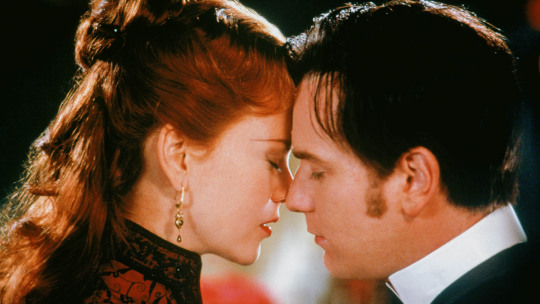
And, though this seems strange to say in a world that has since welcomed Mamma Mia!, Bohemian Rhapsody and Rocketman, making a movie musical early in the millennium was a high-risk pursuit. Luhrmann again: “‘Musicals will never be popular again’ … I can’t tell you how many times I was told that.”
“It’s part of a cycle,” explains Dr. Eleonora Sammartino, an academic specializing in contemporary American film musicals. “It came after a period in the 1990s where musicals had disappeared from the big screen.” Lisa Duffy, Letterboxd member and Doctor of Hollywood Musicals, agrees: “Films coming out [that year] were a lot more dour, so this was a real gamble.”
Nobody understood this gamble better than the film’s co-writer, Craig Pearce, who has been Luhrmann’s close friend and professional partner since the pair were students together. Moulin Rouge! is the third and final entry in what we now know as their red-curtain trilogy, alongside Strictly Ballroom (1992) and Romeo + Juliet (1996).
“Baz had been thinking about the parallels between the Moulin Rouge and Andy Warhol’s Factory,” Pearce recalls. “Places where artists congregate, where it’s more than a place, it’s a petri dish of creativity. Like The Factory, and Studio 54, the Moulin Rouge was a place where the old and the wealthy pay a lot of money to hang out with the young and the sexy.”

At the end of the twentieth century, however, the Moulin Rouge wasn’t all that great (the original had burnt down in 1915). Pearce recalls: “We went to Paris in 1999 on a research trip and discovered, to our horror, that the Moulin Rouge now is just a hideous tourist trap. So we had to go on this journey to find out how this amazing creativity—artists and dancers and musicians—came out of what now feels like this tawdry girlie show.”
With the location and period locked in, Pearce and Luhrmann worked to find the story’s driving force. “This movie wouldn’t work without the exclamation point,” writes Adelaide. Pearce is the first to admit this: “It’s saying it’s Moulin Rouge, but it’s not that one. What we’re trying to do is heighten truth, but you have to start with that underlying truth,” he explains. “It’s not casting around for ‘what would be a cool idea’ because you never come up with one. It’s never as interesting as the truth. Like, there was an elephant in the garden of the Moulin Rouge. And why does that matter? It matters because there are certain inherent logics in the way human beings operate.”
“It's a musical of recycled parts. It’s a story which, beat for beat, has been told for centuries. It’s a staged show drawn from the lives of the characters themselves… This is a film [that] is bold enough not just to say that all art is about finding your own meanings behind someone else’s ideas, and that all art is just copying and stealing, but that this can be totally valid and authentic. When Nicole Kidman sings ‘Your Song’ to the Duke, she’s stealing from the writer, and Luhrmann is stealing from Elton John. But when Ewan McGregor is singing to Kidman, it’s the most magical moment you could possibly imagine. That’s what makes ‘Moulin Rouge!’ a true masterpiece. Cinema has never been more fake, and cinema has rarely been more real.” —Sam
Moulin Rouge! borrows from all over. There are hints of La Traviata, of Cabaret and of Émile Zola’s Nana. There were Toulouse Lautrec’s paintings (John Leguizamo tremendously embodies the painter in the film), Baudelaire and Verlaine’s literature, Jason and the Argonauts, Homer’s Odyssey, and the revues of the 1920s and ’30s. “Moulin Rouge! really embraces that vaudevillian component,” says Dr. Hannah Robbins, a Broadway and Hollywood musicals specialist.


Craig Pearce and Baz Luhrmann writing in Paris (1998) and New York (2019). / Photos from Luhrmann’s Twitter
“This genre lends itself to repetition and fragmentation,” Sammartino expands. “It’s part of the syntax of the musical and has always been, this idea of borrowing from other sources. This doesn’t take away from the daring postmodern approach Moulin Rouge! is defined by, it’s simply further proof that it’s, well, a very good musical.”
Above all else, the core of Moulin Rouge! is inspired by the myth of Orpheus of Thrace and his doomed love affair with the beautiful Eurydice, whom he followed into Hades after she died. “The show must go on, Satine,” the nightclub’s impresario Harold Zidler grimly tells his star, as their world begins to crumble. “We’re creatures of the underworld. We can’t afford to love.”
It wasn’t the first time Pearce and Luhrmann had looked to ancient mythology. Strictly Ballroom’s mantra, which tells us “a life lived in fear is a life half lived” owes everything to David and Goliath. But with the Orphean myth, the screenwriters were looking to dig deeper, to find something much darker. “The Orphean myth is a romantic tragedy in its essence,” Pearce explains. “David and Goliath is more youthful, and it’s about saying that belief can conquer anything. But as you get older people get sick, they die, and life is about resilience and finding ways to embrace the hard things in life and move forward.”
That might sound antithetical to the all-singing, all-dancing nature of the movie musical, but the genre has been trying to tell devastating stories like Moulin Rouge! for decades. “Hollywood is rarely interested in buying and remaking stories with devastating endings as much as stage musicals are,” Duffy explains. (See: Les Misérables, Phantom of the Opera.)
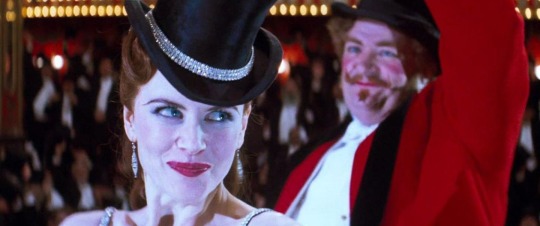
This reluctance can be traced back to the classic era, during which there were rules about the ways a musical could end under the censorship laws of the Production Code. Simply put, they had to have a happy ending. (Which also led to a fair amount of bizarre deus ex machina to guarantee a nice, cheery final act).
But then in the 1960s the Code fades away, and Hollywood starts engaging with violence, sex and explicit trauma on-screen. “We have much more freedom in the contemporary era to have people die explicitly,” Duffy says. “And that’s why we keep returning to Moulin Rouge!: there’s the explicit negotiation of our entry into the fantasy world, and then we’re devastated, and the curtains close and we’re in reality again.”
“It’s one of the great 21st-century films. Baz Luhrmann is only good when figuring out how to make historical periods of excess into contemporary displays of grotesquerie, somehow turning great films (‘French Cancan’) or great literature (‘The Great Gatsby’) into tacky Technicolor vomit that somehow understands the underlying sorrow of the material better than any serious-minded adaptation.” —Jake
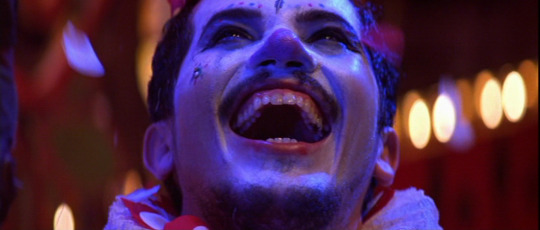
The red-curtain trilogy has a distinct set of rules: one, the viewer must know how the film ends from the start; two, the story must be set in a heightened world; and three, it must contain a device that keeps the audience awake at all times, whether that be ballroom dancing, scattershot Shakespearean dialogue, or pop songs.
“Part of the appeal of the artifice is that it gives the audience permission to say, ‘This isn’t real, you’re about to see a fantasy, and that’s okay,’” Duffy says. “The pleasure is the fantasy of it. The whole film is us seeing how Christian is imagining what happened—and the musical is the most extreme genre that allows such imagination.”
The point was never to temper the elaborate, hyper-aware fakeness of it all, but to really commit to it. Says Robbins, “Musicals are ultimately artificial and exclusively constructed. And that’s what Moulin Rouge! achieves and quite a lot of films don’t. It goes, ‘This is where the story is going, this is the energy, this will be played in the soundtrack.’ There’s a deliberate thought process there.”
Luhrmann recently said: “The way we made the movie is the way the movie is.” An under-explored aspect of Moulin Rouge! is how the whole affair, with its ‘Spectacular Spectacular’ musical-within-a-musical device, is an insider’s guide to the mechanics and politics of making ‘big art’. How money can control both the art (the dastardly Duke insisting on “his” ending), and the artists (Satine is never told she is dying, because she is the golden goose upon whose shoulders the success of the company rests; Christian is likewise left in the dark, because he is the scriptwriter who needs to finish writing the show. Both are wrung dry for their talents).
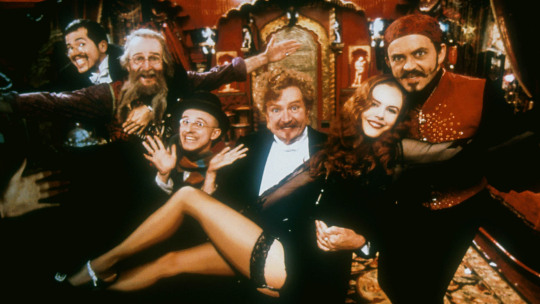
There are shades of Luhrmann in Zigler, the impresario juggling cast, crew, investors and opening dates (Moulin Rouge! was originally slated for December 2000). Christian and friends in playwriting mode are surely Pearce and Luhrmann themselves, searching for the most economical way to say “the hills are vital, intoning the descant”.
And, from the show-within-a-show rehearsals, to the bustle of the backstage, to the gun-chase through the wooden bones of the fly tower, the production details are Catherine Martin to the very last diamante. Nobody does daring bedazzlement quite like ‘CM’, Luhrmann’s fellow producer and life partner. Electricity was the new, exciting thing in Paris at the turn of the twentieth century and this film was lit.
A necklace worn by Satine as a gift from the Duke was made of real diamonds and platinum. Designed by Stefano Canturi, It was the most expensive piece of jewellery ever specifically made for a film, with 1,308 diamonds weighing 134 carats, and worth an estimated one million dollars. Needless to say, Martin won both costume and production design Oscars for the film.

Also among the film’s eight Academy Award nominees: editor Jill Bilcock, about whose singular craft there is a recent documentary. Her breathless, kaleidoscopic cutting (also deployed in Strictly Ballroom and Romeo + Juliet) dropped us right on the dance floor; one 65-second sequence contained a boggling 85 cuts. And this is on the back of her superbly judged opening, a scene that repeats itself as she places Christian at both the start of his love story, and its devastating aftermath—heartbroken, unshaven, self-medicating, reaching for the words to begin making sense of his loss.
“I wondered, for the first hour of this, how Baz Luhrmann had managed to balance such in-your-face stylistic audacity while maintaining a genuine feeling of care for the characters and their struggles—is it all down to Ewan McGregor’s wonderfully earnest face, or the way Nicole Kidman’s smouldering-temptress persona is worn down by one of the most charming cinematic uses of Elton John’s ‘Your Song’? But as the ‘Elephant Love Medley’ transformed into David Bowie’s ‘Heroes’, I stopped caring, I just swooned.” —Kat
If electricity was the thing that drove the kids wild in the 1900s, the internet was on everyone’s minds in 2001. We were just figuring out how to juggle tabs and text people. The real magic dust sprinkled throughout Moulin Rouge! is, obviously, the cacophonous soundtrack, which made sense to our collective, fragmented consciousness.
“No other musical of the modern era has so perfectly captured the sense of spinning an iPod wheel every 45 seconds to play something else,” writes Jake of the medley of songs by David Bowie, Fat Boy Slim, Nirvana, Police, Elton John, Rufus Wainwright, Madonna and many others.
Luhrmann and Pearce stopped at nothing to get every single track from every single artist they wanted. The journey took more than two years, and some bodies were left at the side of the road. “You constantly have to kill your darlings,” Pearce sighs. RIP to Rod Stewart’s ‘Tonight’s the Night’, The Rolling Stones’ ‘Under My Thumb’, Prince’s ‘Raspberry Beret’ and Fifth Dimension’s ‘Up, Up and Away’. (Hot air balloons were big in 2001.)
"We wanted the music to be modern, because we didn’t want it to feel like a fusty, crusty world,” says Pearce. “We wanted to find the universal modern parallels that have existed since time immemorial.” But it wasn’t just about finding the most popular songs at the time. “The structure had to be driven by the needs of the story,” the screenwriter explains. “The musicals on film that tend to fail are the ones where the music feels like a film clip. If it’s not serving the emotional needs of the story, you very quickly check out and it becomes boring. With good musical storytelling, it builds and builds to a point where you can’t do anything but express yourself through song.”

Has there ever been a more desperately romantic promise than when Christian starts telling Satine he doesn’t have much to give her, before nailing that one perfect high note to reassure her that his gift is his song? Why, yes: when the mirrored love stories of Christian and Satine, and of the penniless sitar player and the courtesan in ‘Spectacular Spectacular’, meet at their dramatic peak, with ‘Come What May’. (The film’s only original song, it had been submitted for the Romeo + Juliet soundtrack by writers David Baerwald and Kevin Gilbert.)
“Moulin Rouge! was successful because it was using songs from different ages and periods, appealing to different audiences with something they could have a connection to. So it wasn’t just boomers, not just millennial or Gen X,” says Sammartino. “Something like Rock of Ages, for example, was much more narrow in terms of the kind of music you needed to like.”
“This film is a dramatic bitch and I love her.” —Mulaney
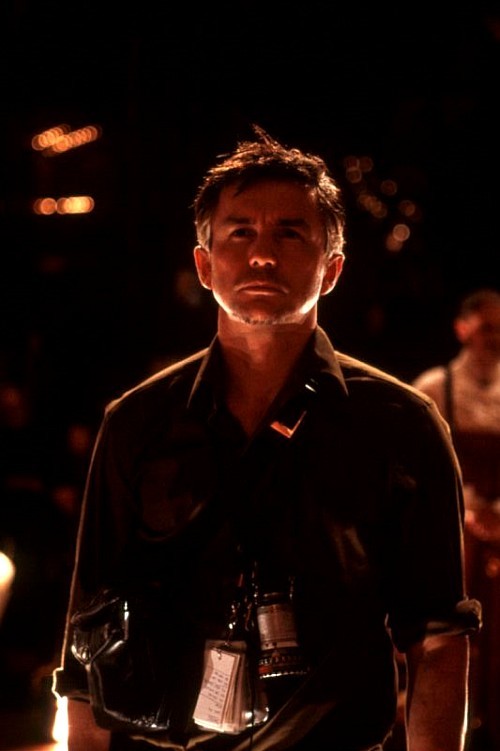
‘Moulin Rouge!’ co-writer and director Baz Luhrmann.
There is a pattern to our most emphatic reviews for the film: they come from relatively young people, who mainly identify as women. It’s something critics anticipated back in 2001. The New York Times wrote, in a fairly ambivalent review, that “young audiences, especially girls, will feel as if they had found a movie that was calling them by name”. We don’t have time to fully dig into the antiquated notion that “low art” (the publication’s quippy headline for that review was “An Eyeful, an Earful, Anachronism”) is aimed specifically at women, but surely we have to ask the question twenty years on: does anyone still think this could possibly be true?
“You’re always writing for yourself, for the film you want to see,” says Pearce. “I like all kinds of different films and I think teenage girls do too.” And let’s remember, it was Harry Styles who said of the broad demographic of his fanbase back in 2017: “Teenage girls—they don’t lie. If they like you, they're there. They don’t act ‘too cool’. They like you, and they tell you.”
Robbins: “The rom-com has made the connection between song and emotional display about female pain. The Emma Thompson crying to Joni Mitchell kind of lineage has tempered musicals—people think that’s what Mamma Mia! is: women and mothers and daughters and feelings.” Dig a little deeper and you’ll find a lot of musical-related data suggesting a broader scope. “When I went to see Frozen on Broadway, kids of all genders were wearing Olaf costumes, much more than princess ones. That is not the narrative Disney would like. And when people gender musicals and think of the princesses franchises, they don’t look to the fact that The Lion King and Aladdin were more successful.”

There has been an undeniable effort to reel male audiences in to see 21st-century musicals. On Hugh Jackman’s welcome, flamboyant career pivot (surprising to anyone but Australians), Duffy says: “Casting Wolverine in Les Misérables and The Greatest Showman is very, ‘See, manly men can do it too!’” Let’s not forget that Ewan McGregor had gotten his big break as freewheeling heroin addict Mark Renton in Danny Boyle’s Trainspotting just six years prior to playing Christian.
Indeed, says Duffy, “more of my male friends have seen Moulin Rouge! than other musicals. The MTV tone might have been significant, and there was the ‘Lady Marmalade’ music video—the fact you have all these beautiful pop stars writhing around in corsets. And just having David Bowie on the soundtrack is like, ‘Okay, this isn’t just girl music.’ Pop music offers an easier way to move past the stigma of show tunes.”
Crucially, Robbins notes that all of this prejudice, and the effort to tear it down, is speaking to, and about, a very specific—cisgender, heterosexual—subsection of audiences. “I always wonder where the critics think the queer audiences are. I do wonder if there’s a cis-het vibe going on that has even more to do with it, reinforcing that norm rather than actually focusing on young girls as an audience.”

I asked my interviewees whether they thought, twenty years on, that Moulin Rouge! would be better received today—and which parts of our contemporary cinematic and musical fabric owe a debt to Luhrmann’s jukebox wonder. “We’re more receptive but we have specific demands,” says Robbins. “And today’s musicals sink or swim on whether they meet those demands. So The Greatest Showman is the Moulin Rouge! of now. I think people would be lying if they didn’t say that the cinematography in Moulin Rouge! hasn’t affected almost every movie musical that has been made since. We wouldn’t have ‘Rewrite the Stars’ if we didn’t have ‘Sparkling Diamonds’.”
Duffy agrees: “So many things that come after you can draw a line directly to Moulin Rouge!—Pitch Perfect, Rock of Ages, Happy Feet… but most significantly, Glee would not exist without this movie. The jukebox musicals of the 21st century owe everything to Moulin Rouge! and the blueprint it lays down.”
Among the films that premiered at Cannes in 2001—David Lynch’s Mulholland Drive, Michael Haneke’s The Piano Teacher—was another kooky little number: Andrew Adamson and Vicky Jenson’s animated Shrek. Two jukebox musicals in the same prestige film festival, at a moment when the genre was considered deeply uncool? What a time to be alive!

If the last eighteen months have taught us anything, it’s that we film lovers enjoy nothing more than a comfort rewatch of our favorites. Moulin Rouge! and Shrek (and French Shrek) delivered untold comfort in the pandemic—but they had also soothed us much earlier, in the months following the unspeakable tragedy of the 9/11 attacks.
“For me it was very much a comfort film,” recalls Duffy, who had discovered Moulin Rouge! as a fresh-faced eighteen-year-old, during her first year away from home, studying in New York. “Part of that was rooted in this really traumatic thing that had happened, and all of us wanting to escape into this fantasy world as much as possible.”
Luhrmann said, in his recent Australian interview, “I love to see people united and uplifted and exulted. It’s a privilege to be a part of helping people find that.” As life outside our homes resumes, Moulin Rouge! will very much be part of a return to exultant living. The live musical—interrupted by Covid—opens in Melbourne in August and on the West End and Broadway in the fall.
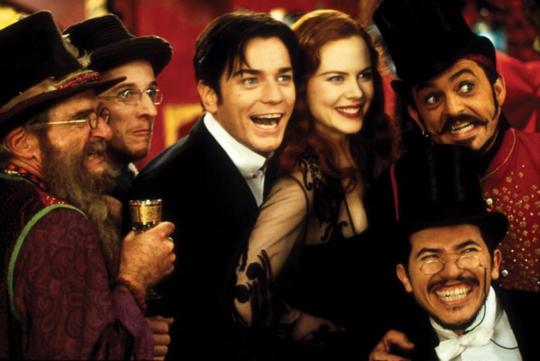
Pearce last saw the film on a large screen in a derelict warehouse in London, at Secret Cinema’s interactive, carnivalesque spectacular. “I have to say, I was really proud of the film,” the screenwriter says, finally letting himself speak fondly of his accomplishment well over an hour into our conversation.
“I mean, some people liked it back in the day, but you’re never really satisfied with your work. You just tend to see the things that could have been better. But seeing the love for the film was really, really emotional.”
Related content
Follow Ella on Letterboxd
Craig Pearce is currently producing ‘Pistol’—a biopic miniseries on the Sex Pistols, directed by Danny Boyle—and his next film with Luhrmann is a biopic of Elvis Presley, with Austin Butler playing the king of rock and roll. Additional thanks to Dr. Eleonora Sammartino, Lisa Duffy and Dr. Hannah Robbins.
#moulin rouge#moulin rouge!#baz luhrmann#catherine martin#nicole kidman#ewan mcgregor#children of the revolution#truth beauty freedom love#musical#movie musical#jukebox musical#paris#australian director#letterboxd
8 notes
·
View notes
Link
https://ift.tt/2X2MXow #

After making her screen debut in 1989, Sandra Oh has enjoyed a remarkable career in both film and television. Although the versatile talent and 12-time Emmy nominated actress is best known for her iconic roles as Cristina Yang on Grey’s Anatomy and Eve Polastri on Killing Eve, Oh has also worked with some of the finest movie directors, including Alexander Payne, Steven Soderbergh, Mina Shum, John Cameron Mitchell, and more.
RELATED: Killing Eve – 10 Best Quotes From The Show
As fans continue to enjoy Oh’s new hit Netflix sitcom The Chair, it’s worth recollecting her best movie moments for those who want to see more of the talented actress on the big screen.
10 Defendor (2009): 6.8

Peter Stebbings’ dark offbeat superhero comedy Defendor stars Oh as Dr. Ellen Park, a psychiatrist who gives hilarious facial and verbal reactions to the outlandish story relayed to her by Arthur Poppington (Woody Harrelson), an ordinary man moonlighting as a vigilante crime fighter.
Cut from the same genre-bucking, irreverent cloth as James Gunn’s Super, once Arthur confesses his secret life to Dr. Park, she convinces the judge to go easy on him and allow him to continue his heroic activity. When tragedy strikes, Oh shows how much heartfelt pathos she can portray by attending a touching ceremony for her patient.
9 Under The Tuscan Sun (2003): 6.8

Written and directed by the late Audrey Wells, Under the Tuscan Sun is a delightfully uplifting rom-com about Frances (Diane Lane), a writer who ups and leaves her life in San Francisco to live in Tuscany after discovering her husband’s infidelity. Oh plays Patti, Frances’ best friend who encourages her to travel to Italy.
RELATED: Sandra Oh – 10 Best Roles, Ranked (According To Rotten Tomatoes)
In addition to the gorgeous locations, breezy tone, and rich cinematography, Oh adds complexity to the story as Patti, a lesbian expecting a child even after her lover Grace (Kate Walsh) has left her. It’s Patti’s visit to Tuscany when she’s nine months pregnant that helps Frances find the courage to pursue true love despite the painful past.
8 Double Happiness (1994): 7.0
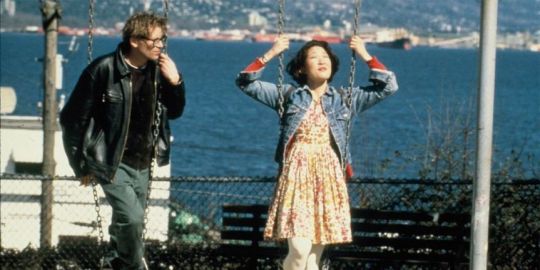
Oh made her feature film debut in Mina Shum’s must-see coming-of-age tale Double Happiness, in which she plays the lead role of Chinese-Canadian Jade Li. The intensely personal semiautobiographical drama shows how divided Jade is between her traditional Chinese upbringing and her modern Canadian lifestyle.
With a natural performance by Oh matched with the authentic, well-observed writing of Shum, the movie is a universally relatable tale of a person grappling with their own identity while trying to appease the expectations of loved ones. In her first film performance, Oh won the Genie Award for Best Actress in a Leading Role, proving what a titanic talent she has been from the start.
7 Rabbit Hole (2010): 7.0

John Cameron Mitchell’s Rabbit Hole is a bruising account of a family dealing with the death of a young child at the hands of a teenage driver. Nicole Kidman gives a memorable and towering performance as Becca, a mournful mother who begins to find solace by interacting with Jason (Miles Teller), the driver who accidentally took her son’s life.
Although she has a smaller supporting role, Oh plays Gabby, a fellow grieving parent who helps Howie (Aaron Eckhart) deal with his loss at the group therapy sessions he and Becca attend. With profound empathy for Howie, she becomes instrumental in his healing process.
6 Meditation Park (2017): 7.1

Twenty-three years after working with Mina Shum for the first time, Oh reunited with the filmmaker for the sweet-natured drama Meditation Park in 2017. The story concerns Maria Wang (Pei-Pei Cheng), an aging woman in the throes of an existential crisis upon suspecting her husband’s infidelity. Oh plays Maria’s daughter Ava, a mother of two who encourages Maria to reconcile with her estranged brother ahead of his wedding and break free from her husband’s hold.
RELATED: Asian-American Movies to Watch If You Loved Crazy Rich Asians
As another trenchant glimpse at the immigrant experience and a statement about the importance of women finding their own voice, Shum’s film is tender, touching, and triumphant.
5 Hard Candy (2005): 7.1
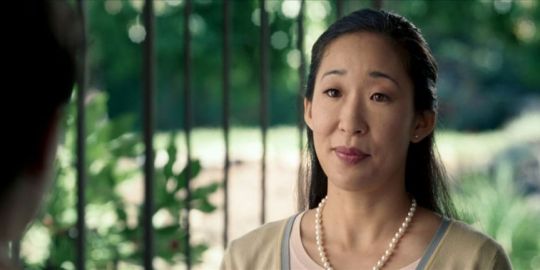
David Slade’s Hard Candy is a deeply unnerving glimpse at a predatory pedophile (Patrick Wilson) getting his just deserts when a teenager (Elliot Page) tricks, traps, and tortures him in his apartment. Oh plays the man’s neighbor, Judy Tokuda, admitting she only took the role due to her working relationship with Page, a fellow Canadian she worked with on Wilby Wonderful the year prior.
With most of the action set inside the inescapable apartment, the visceral terror of the violence that Hayley (Page) exacts on Jeff (Wilson) is met by the suffocating sense of claustrophobia, making for a really upsetting experience. However, the hugely satisfying conclusion helps atone for the squeamish and uncomfortable moments of carnage.
4 Last Night (1998): 7.2

The most unheralded of Oh’s top films happens to be Last Night, a mordant pitch-black comedy about the impending apocalypse and the rag-tag band of Canadians with differing views on how to react. With the end of the world set to strike at midnight, Sandra (Oh) tries to make it out of her stranded position in Toronto and reunite with her husband, Duncan (David Cronenberg). One bad thing after another ensues.
Weird, wild, and ultimately winning, Last Night boasts writer/director Don McKellar’s signature brand of dark humor and anarchic energy. As such, the film has become an unforgettable cult classic among those who’ve seen it.
3 Raya And The Last Dragon (2021): 7.4

With great respect and honor for the rich historical traditions of Southeast Asia, Raya and the Last Dragon is one of Disney’s most beloved recent animated movies. Sandra Oh lends her voice to the commanding role of Virana, the Fang chieftess and mother of Raya’s main rival, Namaari (Gemma Chan).
RELATED: Raya And The Last Dragon – What The Voice Actors Look Like In Real Life
With a moving story, spellbinding animation, and characters never before seen, Raya and the Last Dragon continue to soar in the hearts and minds of viewers.
2 Sideways (2004): 7.5

Directed by her then-husband Alexander Payne, Oh demonstrated her hilarious comedic chops in the indie darling Sideways, a character study of a failing writer at an existential crossroads. The boozy road trip follows Miles (Paul Giamatti), an uptight novelist, and his lecherous pal Jack (Thomas Hayden Church), as they hit Santa Barbara wine country on a tasting tour.
Praised for its excellent performances and light tonal touch between comedy and drama, Oh gives a standout turn as Stephanie, a cool sommelier who has a steamy love affair with Jack (whom she does not know has a fiancee). When she finds out, she goes absolutely ballistic in one of the movie’s funniest moments. The story is so sharply penned that it won an Oscar for Best Writing, Adapted Screenplay.
1 The Red Violin (1998): 7.6

Despite playing a bit role as Madame Ming in the fifth and final chapter of The Red Violin, the ambitious epic ranks among Sandra Oh’s most well-received movie to date. The film traces a famed 17th-century Violin from its creation in Italy to its auction in modern-day Montreal, and all that the instrument endured in creating some of the most beautiful music the world has ever heard.
Praised for its sumptuous set decorations and costume designs, Oscar-winning original music, intelligent story, and a throwback style of filmmaking that calls to mind the grand epics of the past, the resonance of The Red Violin is still felt today.
NEXT: Steven Spielberg’s 10 Best Historical Epics
#marvel #avengers #marvelcomics #spiderman #mcu #ironman #comics #captainamerica #thor #avengersendgame #marvelstudios #xmen #dc #marveluniverse #art #cosplay #tomholland #hulk #disney #comicbooks #dccomics #peterparker #tonystark #blackwidow #marvellegends #endgame #deadpool #marvelcinematicuniverse #loki #bhfyp
The post Sandra Oh’s 10 Best Movies, Ranked (According To IMDb) appeared first on undertheinfluencerd.net.
#entertainment, screenrant #tumblr #aesthetic #like #love #tumblrgirl #follow #instagram #photography #instagood #likeforlikes #s #likes #art #cute #o #girl #followforfollowback #a #tumblrboy #grunge #fashion #photooftheday #tiktok #l #photo #sad #k #frases #f #bhfyp
5 notes
·
View notes
Text
The Many Lives of Lee Miller: Surrealist icon who photographed World War Two
If you were one of the few women photographers accredited by the U.S. Army at the start of World War II, chances were you were far from the front lines. Military regulations at the time dictated that female photojournalists, unlike their male counterparts, were not to enter combat zones.

But Lee Miller, the Poughkeepsie-born photographer and noted Surrealist operating as British Vogue’s war correspondent, was not one to be constrained.
Miller had made a habit of not taking no for an answer long before she accompanied American forces to document scenes such as the Blitz; nurses operating hospitals after D-Day; women serving across the armed forces; and just-liberated concentration camps.

Elizabeth ‘Lee’ Miller was born on the 23 of April 1907 in Poughkeepsie, New York. She was the middle child of Florence and Theodore Miller, a mechanical engineer and avid amateur photographer. She was something of a tomboy, always ready for the next big adventure and to try the biggest stunt.
Her first coup was gracing the cover of U.S. Vogue in 1927 at age 19. Lee Miller was walking down a crowded street in Manhattan. She was ravishingly beautiful: blonde hair stylishly bobbed, lips painted red, her slim figure clad in the latest fashions from Paris.
Perhaps it was Paris she was thinking about so deeply. Whatever it was it absorbs her entirely that as she stepped off the sidewalk she didn’t see a car speeding towards her.
At the last minute a man whisked her to safety. He turns out to be none other than the publisher Condé Montrose Nast. As soon as he saw the woman he saved, he decided she must model for his magazine.
A few short months later, Lee Miller’s face, drawn by Georges Lepape with the New York skyline for a backdrop, stares out from the cover of Vogue.

That cover launched Lee Miller’s modelling career. Within months she became a fixture on the New York social scene, hobnobbing with the likes of Charlie Chaplin, George Gershwin and the Vanderbilts.
Fashion greats such as photographer Edward Steichen zipped her into Lanvin and Lelong, draped her in pearls, swathed her in velvet. In one picture she models a Chanel evening gown covered with geometric embellishments, her body resembling a glorious art-deco building.
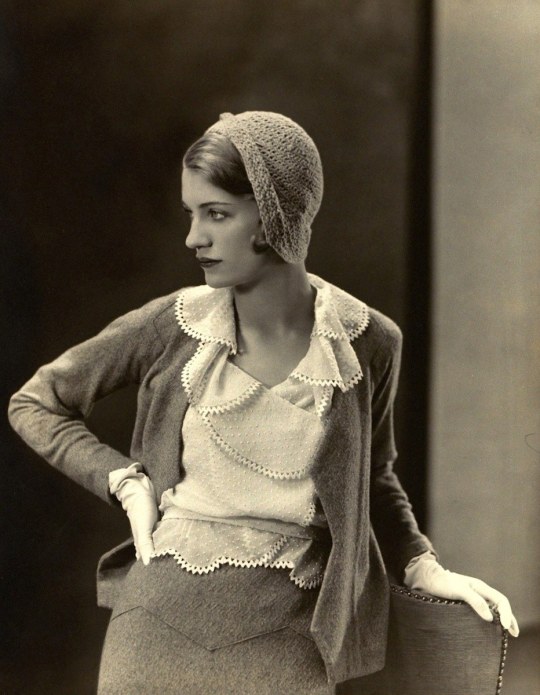
Lee was fêted and pursued by suitors. A glassware manufacturer even moulded a champagne coupe in the shape of her breast. It was all very glamorous but, for Lee, not wholly satisfying. Later, remembering her New York years, she said, ‘I looked like an angel but I was a fiend inside.’
This contradiction – stemming from a traumatising childhood into early adulthood,
Her father, Theodore, was an amateur-photographer and had begun to photograph his naked daughter long before that, in 1914, when she was seven. According to Miller herself, in that year, she, then known as Elizabeth, had been sent to stay with family friends while her mother was in hospital.
During the trip, she had been raped by a sailor; the attack left her with gonorrhea. For the next year, the child was subjected to daily douches of potassium permanganate, and k twice-weekly visits to the hospital to have her cervix painted with picric acid. Everything she touched at home was immediately sterilised.

It was during this year that Theodore had begun to photograph his daughter in the nude, his first composition being a take on the French artist Paul Chabas' September Morn, a painting of a nubile girl bathing, which had caused a scandal when it was shown in New York in 1913.
For his own picture, Miller required his daughter to pose, nude but for slippers, in the deep Poughkeepsie snow: the resulting picture was called "December Morn". Theodore made it using a stereoscopic camera, so that, viewed through accompanying glasses, his naked child appeared three-dimensional.
The early childhood experience would plague her throughout her adult life, and arguably cause her to constantly try to reinvent herself, wondering if she ‘ever was meant to fit together’.

Those reinventions – as a key figure in the Surrealist movement, fashion photographer, muse and tormented war correspondent – have made her the subject of plays, film scripts (Nicole Kidman wanted to play her in a film written by David Hare that was never made).
Reinvention of otherworldly beauty was also so evident in all her photographs. But Lee wasn’t happy as a model. A sketch she drew in her journal in 1930 shows a woman standing against a studio backdrop, daggers pinning her into place, as another woman in a hat looks on. No wonder, then, that she was hungry to forge her own identity beyond the camera’s frame – a frame that, to a woman who had been looked at by men her entire life, represented an implicit power imbalance.

She gave up her modelling career and set sail for Paris, intending, as she provocatively stated, to ‘enter photography by the back end’.
Bags of confidence, together with letters of introduction from Edward Steichen, convinced Man Ray to take her on as his assistant. He was instantly enchanted and their professional relationship blossomed into a love affair so tumultuous that it affected them both for years afterwards.
Miller was to befriend other iconic Parisian artists like Max Ernst and Picasso and intellectuals like Jean Cocteau. She would vacation with some of the most prominent figures in the art world at the time. Picasso would paint Lee six times and the two remained friends throughout the rest their lives. Picasso wanted to bed her but she held her distance.
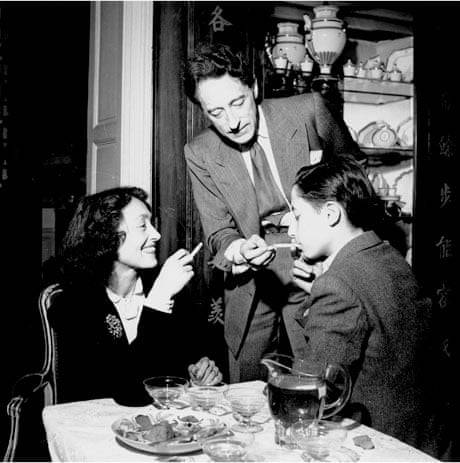
It was Lee Miller, not Man Ray, who discovered the photography technique known at "solarisation" bu turning on a light in their darkroom before the negatives had fully developed. It creates a dark line around the subject of the photograph and created groundbreaking images at the time. Ray is often credited with this discovery and he used it often in his own work, but it was actually Lee Miller who made the first picture of its kind on accident.
Man Ray’s portraits of Lee are sensuous and romantic, but even he never seemed able to see her as a whole, often depicting her body broken up into pieces.
He painted her lips floating disembodied in a mackerel sky in ‘Observatory Time: The Lovers’, and in his photographs her breasts, neck and eyes are removed from their context, palpably humming with sexual energy, the ultimate surrealist objects.
In December 1930, Miller's father, Theodore, had come to Paris from Poughkeepsie, New York, to see his daughter. Like any good parent might, he had taken pictures of her. Unlike most fathers, these photographs were shot in the nude, in the bathtub of their shared hotel suite. Lee Miller was 23.
The shots Man Ray took of Lee and Theodore Miller, she in a demure print frock and curled, child-like, in her father's lap, are deeply weird. They seem less of a father and daughter than of an older man and his much younger lover.
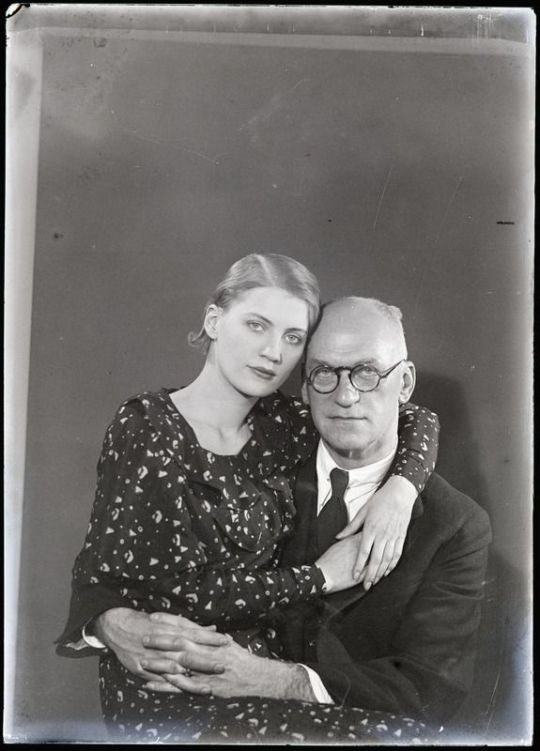
Perhaps Ray had heard rumours that Theodore had been Lee's actual childhood abuser, or he may have imagined it for himself. (No charges were ever brought against the unidentified sailor-rapist.)
In terms of age, Ray's own relationship with Lee was also ambiguously paternal: he was 17 years older than her, a pattern that would mark all her relationships with men. At any rate, Theodore and Ray seem to have gotten along famously. Together, the two men photographed Lee, nude, lolling on a bed with three other naked women.

It is hard not to see all this in psychological terms, if not in moral ones. Cursed with a perfect beauty, Miller became a focus of Ray’s internal need to violate. For Man Ray, this was aggravated by the masculine drive to compete.
If the countless celebrities photographed by Man Ray – Wallis Simpson, Aldous Huxley, Virginia Woolf, Picasso, Chanel, Schiaparelli, himself – the one he went back to most obsessively was Lee Miller. You can see why. Miller was a physical ideal, the kind of perfectly moulded, ice-blonde beauty beloved of Hitchcock; flawless, or at least imaginably so.
Lee Miller and Man Ray's exciting, passionate and tumultuous relationship ended and Man Ray did not take it well. In fact, one of his most famous pieces, Indestructible Object, includes her eye ticking on a metronome.
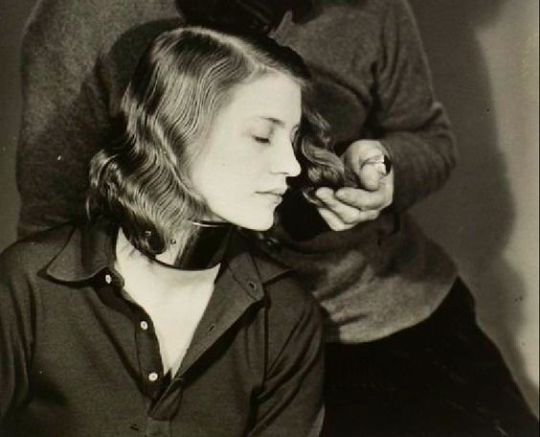
Ray's instructions to fans on how to make their own version of the work suggest the violence of his anatomical method. "Cut out the eye from a photograph of one who has been loved but is seen no more," he writes, bitterly. "Attach the eye to the pendulum of a metronome and regulate the weight to suit the tempo desired. Keep going to the limit of endurance. With a hammer well-aimed, try to destroy the whole at a single blow."

That done, the photographer, ever the drama queen, sat for a self-portrait called "Suicide" with a noose around his neck and a gun pointed at his head.
Hell hath no fury like a Surrealist scorned.

When their affair ended, Lee moved back to New York and opened her own studio, where she worked ‘in the style of Man Ray’, as she advertised in a bold appropriation of his name.
She hardly needed the help. Clients such as Saks Fifth Avenue and Elizabeth Arden paid handsomely for pictures by the woman who was herself ‘one of the most photographed girls in Manhattan’.
But in just a few years the Lee Miller Studio closed when Lee married an Egyptian, Aziz Eloui Bey, and moved with him to Cairo. She felt stunted by Egypt’s restrictive society but produced some of her best work there, driving into the desert with her trusty cocktail kit in the boot to take photographs of the landscape.
Her husband, however, let Lee spend extended holidays in Europe with the Surrealist set, where she met painter and art collector Roland Penrose, the man who eventually became her second husband. They would be happily married for the rest of their lives until death. She at last found someone who accepted her whole. But it still wouldn’t be enough for Lee.

By 1939, it was time for another reinvention. War broke out, the Blitz rained down on London, and Lee, urged on by her friend, the photojournalist, collaborator and sometime lover David Scherman, got accredited as a war correspondent for (of all places) British Vogue.
Her editor, Audrey Withers, expected soft-focus photo-essays about war privation, but Lee had other ideas.
Her reportage was gruesome, intimate and important. On the front lines at the siege of Saint-Malo, Lee documented the Americans’ first use of napalm and described a company ready for action, ‘grenades hanging on their lapels like Cartier clips, menacing bunches of death.’

She shot close-ups of the faces of German Nazis who had committed suicide in Leipzig and took powerful portraits of starving prisoners following the liberation of Dachau and Buchenwald.
When she arrived in Paris during the Liberation the first thing she did was go to Picasso's studio. There they are pictured smiling holding each other tight, probably beyond relieved that they were both alive. Picasso is quoted saying in astonishment "the first Allied soldier I should see is a woman- and she is you."
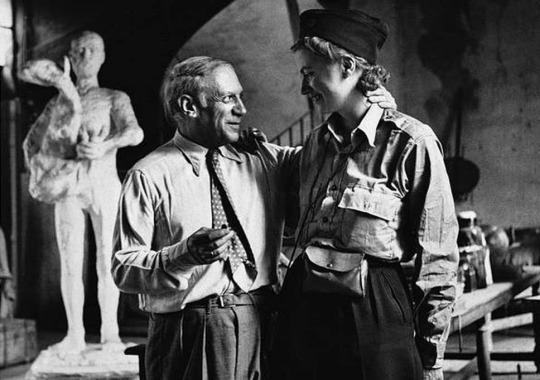
When Hitler fled Munich at the end of the war, Lee and Scherman were the first of the press corps to reach his apartment, where they drank his cognac and napped in his bed. They propped a picture of Hitler on the rim of his bathtub, set Lee’s dirty combat boots on the bathroom rug and took the now-famous photograph of her bathing in Hitler’s tub.
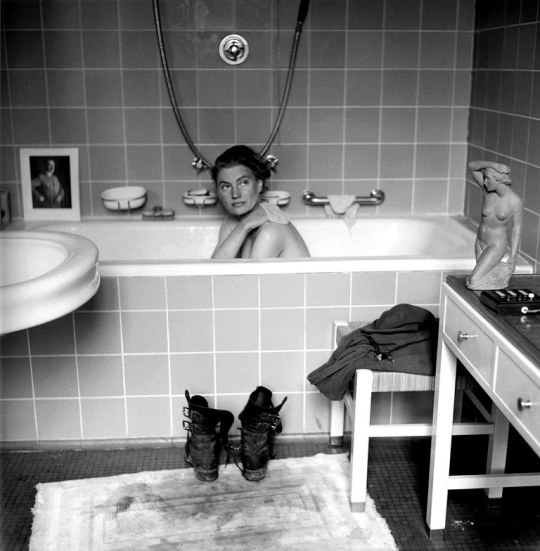
The war made Lee feel alive.
The image of Miller in Hitler’s tub was the one that led to the end of her Vogue career. The public was outraged at what they interpreted as flippant disregard for the ravages of war. Being accused of insensitivity inevitably took its toll, but it was what she saw, felt, and experienced during those years that would eventually send her into a struggle with depression.
She loved her uniform, tailored on Savile Row. She loved roughing it: washing in her helmet and subsisting on K-rations. And for a woman always searching for meaning in her life, documenting the war for readers back home gave her purpose. ‘Believe this,’ she cabled to Vogue, and the pictures she sent back were indeed horrifying. They came at a cost: Lee was never able to distance herself from her subject. She threw her entire self into her work.

Lee suffered mightily postwar.
The trauma of what she had seen haunted her for the rest of her life. Today we would call it PTSD. In postwar England, Lee was told by her doctor ‘we cannot keep the world permanently at war just to provide you with excitement’.
On her return to London after the war, she was feted. "Who else has written equally well about GIs and Picasso?" her editor said. "Who else can swing from the Siegfried line one week to the new hip line the next?"

Desperate to ward off a sense of anticlimax, she returned to eastern Europe. But soon she was pregnant at 40 years old and finding the prospect of motherhood scarier than any front line.
She missed the action, despite suffering post-traumatic stress. She also felt increasingly sidelined: in staid, patriarchal postwar Britain, her husband was the one in demand.

Finding the inspiration to write and take photographs became harder and eventually she gave it up entirely, hiding more than 60,000 negatives and contact sheets in the attic and becoming so tight-lipped on the subject that even her own son, Antony, knew nothing about her war work until he was an adult. An entire piece of herself was boxed up and placed out of sight.
Depressed at her loss of looks and gain in weight, she found solace in drink and cooking elaborate gourmet meals for her guests at Farley Farm House in East Sussex, her home until her death in 1977.
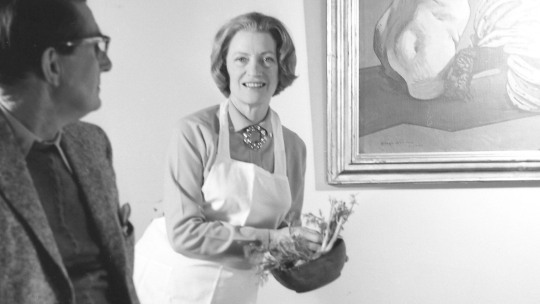
She could have written a very good cookbook by all accounts. She was a virtuoso chef.
She remained friends with the Paris crowd. In particular she was close to Picasso. Lee Miller's son recalls going over to Picasso's home as a child. He even wrote a book about the time he bit Picasso, as a child, called ‘The Boy Who Bit Picasso’.
Lee even reconciled with Man Ray. Lee and Man Ray last met in London in 1975, at Man Ray's retrospective at the Institute of Contemporary Arts. By now, he was in a wheelchair and Lee Miller was a drunk.
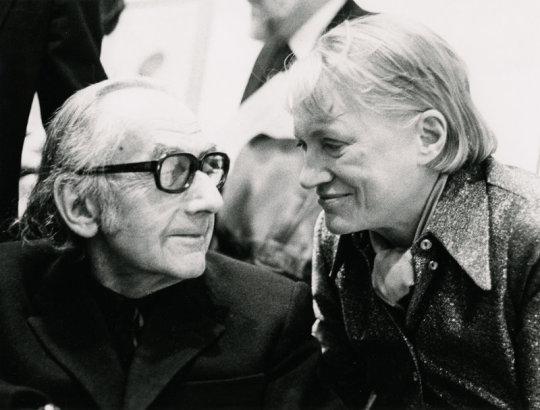
Lee Miller died of cancer in 1977. By the end she was overweight, an alcoholic, ravaged by depression, and tortured by her husband’s affair with a trapeze artist. Anyone meeting Lee Miller then would have been surprised to know that she was once considered the most beautiful woman in the world, second only to Greta Garbo.
But just as she, and her reputation, went out of sight for years. There has in recent years been a resurgence of interest in Lee’s photography, bringing her legacy, and her enduring appeal, further into the light.
As a female icon she never saw herself as a victim. It's remarkable that Miller was able to delight in her body (and in the pleasure others took from it). She saw sex and love as two very different beasts. She was very comfortable living out the truth as she believed it."Emotionally, I need to be completely absorbed in some work or in a man I love," she wrote, but she didn't see why going to bed with someone should upset whichever man she was currently in love with.
Lee insisted that she couldn’t be kept and that women should be able to be as sexually free as men. She was radical, and people made her suffer for it - Man Ray included.
Strikingly beautiful, she was used to submitting to the male gaze and even subverting it. A less spirited woman might have been crushed by these alpha males, but Miller, unfazed, determinedly transformed herself from passive model to active artist.

Her son, Antony Penrose, observed in his 1998 biography of his mother, The Legendary Lee Miller: Photographer, 1907–1977, her unique background capturing uncanny moments and haunting, bizarre portraits during the heyday of the Surrealist movement served her well in war photography. Penrose wrote:
“Unexpectedly, among the reportage, the mud, the bullets, we find photographs where the unreality of war assumes an almost lyrical beauty....On reflection I realise that the only meaningful training of a war correspondent is to first be a Surrealist—then nothing in life is too unusual.”
But it was the very nature of unconventionality of her career trajectory that hampered her historical reputation.
Her early association with the Paris Surrealists - particularly her role as Man Ray's "perversely enchanting muse" - overshadowed her own artistic accomplishments.
Her abandonment of photography, and the consignment of all her work to her own attic also limited her impact during her lifetime.
Her association with fashion also coloured the interpretation of Miller's work. As her biographer Carolyn Burke states, "to this day, her life inspires features in the same glossy magazines for which she posed...this approach turns the real woman in to a screen onto which beholders project their fantasies", and further perpetuates the legend of Lee Miller as an "American free spirit wrapped in the body of a Greek goddess".
The force of her beauty, effervescent personality and high octane biography will always remain central to interpreting her work.
Today Miller has been recognised as among the most original and ambitious photographic artists of the 20th century, and a subtly transgressive artist, who - as Lynn Hilditch asserts in Lee Miller, Photography, Surrealism and the Second World War - took off from her Surrealist background and "pushed the boundaries both of art and war photography, often using unconventional methods to comment on such multifaceted issues as sex, gender, death, and war"
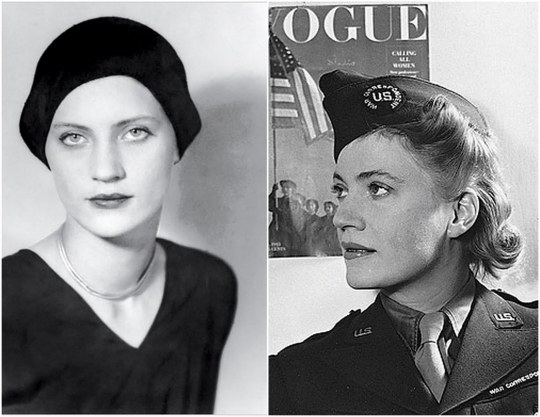
200 notes
·
View notes
Photo
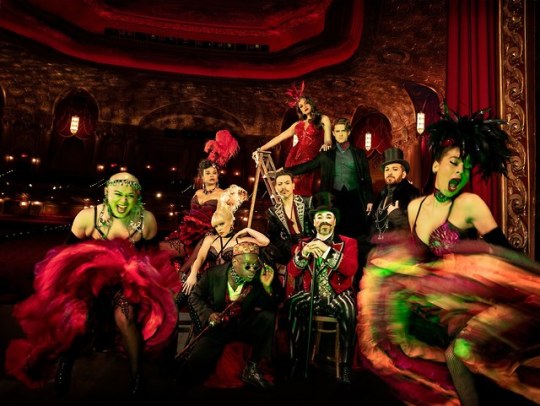

Moulin Rouge for VOGUE!
(These are the HQ Photo Versions!)
Moulin Rouge!’s Broadway cast, photographed at Kings Theatre in Brooklyn.
Sittings Editors: Hamish Bowles, Alexandra Cronan.
Produced by 360pm. Set Design: CJ Dockery at Mary Howard Studio; Costume Designer: Catherine Zuber; Choreographer: Sonya Tayeh
Photographed by Baz Luhrmann, Vogue, July 2019
July 2019 Vogue (Online)
BAZ LUHRMANN WAS BORN to reinvent the movie musical for a new generation—which is exactly what he did in 2001 with Moulin Rouge!, his deliriously romantic mash-up, set in 1890s Paris, of La Bohème, La Traviata, and the Orpheus myth, with a soundtrack that exploded with modern-day pop songs, lavish Technicolor sets and costumes (by his wife, Catherine Martin), and a hyperkinetic cinematic style that drew on MGM musicals, MTV videos, and Bollywood spectaculars. The motto of this blatantly artificial world, served with a knowing wink (which nevertheless swept us up in its very real, very breathless emotions), could be borrowed from William Blake’s The Marriage of Heaven and Hell: “Enough! Or too much.”
In his own way, the brilliant theater director Alex Timbers—whose work includes Bloody Bloody Andrew Jackson, Here Lies Love, and, most recently, Beetlejuice—was born to reinvent Moulin Rouge! for the stage, as another generation of New York audiences will discover when his electrifying, eye-popping, and blissfully over-the-top adaptation of Luhrmann’s masterpiece opens on Broadway, after a smash run in Boston, this month.
“I’ve spent my life taking classics and interpreting them in radical ways,” Luhrmann says, “so how could I not applaud someone taking a work of mine and interpreting it in a radical way? You have to interpret things for the time and place you’re in. In the end, it’s still a tragic opera, but Alex applies himself to it in such a dexterous way that there’s irony and fun and music and emotion.”
Luhrmann grew up in Herons Creek, a tiny, remote Australian town with a total of seven houses in it, where, he says, “if you didn’t have a good imagination and an ability to create worlds in your mind, you were lost.” Fortunately his family, which ran a gas station and a pig farm, also ran the local movie theater and had a black-and-white TV set (which showed exactly one channel), and Luhrmann devoured a steady diet of old movies, including musicals, with which he fell in love. His mother was a ballroom-dance instructor who started giving him lessons early, and his father insisted that Luhrmann and his siblings study painting and music. Before long he was staging little shows, performing magic tricks, making films with his father’s 8-millimeter camera, and acting in school plays.
Apparently it was the ideal upbringing to produce an artist of dazzling originality, one with a singular, idiosyncratic vision and an expansive playing field: film, theater, opera, commercials, music videos, pop songs. After the success of his first two films, Strictly Ballroom and Romeo + Juliet—both of which had healthy doses of movie-musical DNA encoded into their cinematic language—Luhrmann wanted to take on the genre itself. He and his co-writer, Craig Pearce, set their film in Belle Epoque Paris, in and around the legendary Moulin Rouge nightclub, telling a tragic love story straight out of verismo opera with the Orpheus legend—a young poet and musician travels to the underworld in search of his dead love, Eurydice, and is reunited with her only to lose her again, emerging forever changed—as its mythical underpinning.
But Luhrmann also had what he calls a “preposterous conceit” that allowed his Orpheus—a Bohemian poet named Christian, played by Ewan McGregor—to metaphorically enchant the very rocks and stones to follow him because of his voice: “When our poet opens his mouth, ‘The hills are alive with the sound of music’ comes out of it,” he says. “Whether you like The Sound of Music or not, it’s a giant hit that’s got artistic cred—so it’s a funny, concise way of saying ‘The guy has magic.’” Preposterous or not, the conceit turned the love story between McGregor’s Christian and Nicole Kidman’s doomed Satine, a nightclub star and courtesan, into a pop fantasia, giving the music its audience had grown up with—from “Your Song” to “Lady Marmalade”—an operatic grandeur.
Luhrmann had long wanted to bring Moulin Rouge! to the stage but felt that he wasn’t the right person for the job—he worried that he was too close to the material and might be overprotective of it. Enter Alex Timbers, 40, a downtown wunderkind who has brought the cheeky, postmodern spirit of his theater company Les Freres Corbusier to Broadway and shares with Luhrmann a restlessly playful and inventive mise-en-scène. “When I saw Bloody Bloody Andrew Jackson, I could tell that his aesthetic and the way he told a story—very high-energy, very theatrical, ironic but also moving—had a certain kinship with mine,” Luhrmann says. “And after I met him, I knew that he would have his own interpretation but also understand the language of the film.”
The biggest challenge Timbers and his team faced was how to bring the film’s hypercinematic exuberance alive on a stage. “We had to create a visceral and kinetic excitement using an entirely theatrical vocabulary,” Timbers says. “We don’t have any of those virtuosic techniques like close-ups and Steadicam and music video–style editing, but you want the show to be able to leap over the footlights—emotionally, but also as a spectacle. So we use a lot of techniques to do that.”
Do they ever. From the moment you enter the theater, it’s clear that Timbers has realized his mandate to make the show—which he’s been working on for the past six years—“360.” It’s as if you’ve walked into the Moulin Rouge itself, courtesy of the gorgeously overwhelming set (by Derek McLane) that greets you: There are hearts within hearts, chandeliers, the stage flanked by a windmill on one side and an elephant on the other. Then out come the corset-clad boys and girls of the night (who come in all colors, shapes, and sizes) and the fashionable members of the Parisian demimonde in Catherine Zuber’s fabulous costumes. The next thing you know, “Four Bad Ass Chicks from the Moulin Rouge,” as the script identifies them—propelled onstage by Sonya Tayeh’s wildly exuberant choreography—are belting “Hey sista, go sista, soul sista, flow sista,” and we’re off to the races. “I wanted to build this exotic, intoxicating world that felt beautiful and dangerous and gritty and sexy,” Timbers says. “It felt really important for the sets and the costumes to use period elements, and for us to be ruthless about that, but to put them in a form that feels contemporary and surprising.”
The seven-time Tony-winning costume designer Zuber (The King and I, My Fair Lady) has done that and then some, tipping her hat to Catherine Martin’s designs for the film without imitating them. She’s even managed to design Belle Epoque finery that allows the dancers the freedom of movement to execute Tayeh’s propulsive choreography. Zuber is also a master of using costumes to reveal character and situation, as with the ornate gown she designed for Satine after she becomes the Duke’s courtesan and enters his glittering world. Inspired by designs from John Galliano’s 2006 couture collection, it features a bodice that looks like a cage and three rows of lacing down the back. “It’s almost like she’s a prisoner,” Zuber says.
Playing Satine this time around is Karen Olivo (West Side Story, Hamilton), who brings very different qualities to the role than Kidman, both physical (Olivo is a woman of color) and temperamental (desperate, determined, and down-to-earth, as opposed to ethereal). Aaron Tveit (Next to Normal, Catch Me if You Can), meanwhile, sings like a dream and brings the requisite dewy idealism to the naive Christian, but with a hint of something edgier.
The story is very much the same as the film’s: Satine is the star attraction at the Moulin Rouge, owned by the rapacious Harold Zidler (Danny Burstein), who is in financial hot water and in danger of losing the club. Christian and Satine meet and fall head over heels, but she has been promised by Zidler to the villainous Duke (Tam Mutu), who can give her the bejeweled life she’s always dreamed of, forcing her to choose between that and true love. Meanwhile, Christian and his pals Santiago and Toulouse-Lautrec (Ricky Rojas and Sahr Ngaujah) are writing a show, bankrolled by the Duke, that is meant to save the Moulin Rouge from going under. Then, of course, Satine has this persistent cough and . . . well, you know.
The big difference in terms of the storytelling is that book writer John Logan (Red) has fleshed out and deepened the characters and the relationships between them. “We looked at the major characters, asked what their backstories were, and tried to figure out how grounded they could possibly be in psychological realism and yet still be heightened in that way that musical theater demands,” Logan says. “How did Satine get to be this sparkling diamond—and what’s the price she’s paid along the way?”
But the boldest change—and in many ways the heart of the show—is in the new songs, which give Moulin Rouge! fresh emotional resonance (and whip the crowd into a frenzy). Along with the familiar Bowie, Madonna, and Elton John tunes, expect to hear from the likes of Outkast, Sia, Beyoncé, Fun, Adele, and Lorde, to name but a few (there are more than 70 songs in the show). To curate Moulin Rouge!’s dizzying playlist, Timbers, Logan, and music director/genius Justin Levine holed up in a Times Square hotel room with a digital keyboard, dredged up their musical memories, and took note of what worked. Their taste is impeccable, whether using a song for its sheer exuberance, as with a rousing version of Lady Gaga’s “Bad Romance,” or to reveal a character’s inner desires, as Satine does with Katy Perry’s “Firework.”
Logan has been blown away to see how powerfully audiences have connected with the show—and the songs. “I went to a wedding recently, and when the dancing started, I heard half our score being played, which was wild,” he says. “And when you see audience members respond to the songs—‘They’re using thatsong? Oh, my God! No way!’—you can feel how excited they are. It’s an experience I’ve never had before. It’s magic.”
#moulin rouge#aaron tveit#karen olivo#danny burstein#vogue#Baz Lurhmann#moulin rouge broadway#moulin rouge musical#vogue magazine#articles#features#ricky rojas#tam mutu#sahr ngaujah#robyn hurder#jacqueline b arnold#jeigh madjus#holly james
335 notes
·
View notes
Text
Bombshell (2019)
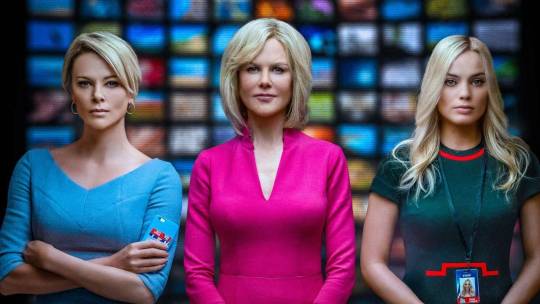
Directed by Jay Roach
Rating: 62/100
Bombshell is Hollywood’s first foray into the #MeToo movement; turning the spotlight on Fox News Corporation’s 2016 sexual harassment scandal. Roach adopts a threefold narrative; jumping between the stories of two high-profile news anchors at the station, Megyn Kelly (Charlize Theron) and Gretchen Carlson (Nicole Kidman), as well as, the fictionalised up-and-comer Kayla Pospisil (Margot Robbie). These narratives are unified by their ominous villain: Fox CEO Roger Ailes (John Lithgow). Roach’s film begins by diving headfirst into the 2016 presidential campaign - more specifically Megyn Kelly’s infamous twitter-spat with Republican candidate Donald Trump. Refusing to tow the company line, Kelly decides to confront Trump on his toxic misogyny, but soon finds herself scapegoated and lampooned by her own broadcaster, whose only interest is in satiating its audiences’ thirst for scare-mongering stories and confirming their viewers’ collective biases, in its hunt for the white whale: greater viewing figures .Similarly, Carson is also disgruntled by the internal misogyny of the company and starts to bite back, but finds that her outspokenness pushes her to relative obscurity and dismissal. The man behind the toxic culture, as well as, the women’s harassment is Ailes. Lithgow, barely recognisable in his bulging prosthetics, approaches the role with a barbaric and fiery energy, enveloping each scene in a litany of profanity and sexist jabs. Ailes is characterised by Roach as a paranoid and powerful monster, whose tentacles extend throughout the corporation, allowing him to continue his patterns of abuse by silencing his victims with promises of stardom and threats of termination.
Although, stylistically and tonally at least, Bombshell attempts to emulate the likes of McKay’s The Big Short and Vice (which is unsurprising considering writer Charles Randolph is behind the screenplay), with it’s quick-cutting exposition heavy scenes and tight dialogue. However, what we end up with in reality, is a film which is wholly coercive for the sake of dramatic effect. For Roach is unable to find a solution to his central conundrum: how do we make a film about sexual abuse, where the victims, for the majority of the audience, are considered morally abject? Instead of confronting the subject, or allowing the audience to draw their own conclusions, or use their own rationale to separate abuse from ideas; what we get instead is ideological whitewashing to make the character’s more empathetic to an overwhelmingly liberal audience. Characters, who have spent decades live-on-air espousing right-wing ideas, become suddenly disenfranchised or wink at the audience to let them know that they are just mercenaries in the ideological warfare. Randolph parachutes in a fictionalised closeted lesbian and democrat, as a researcher who fears exposure and despises the company, but has been unable to find employment elsewhere. Even Pospisil who believes in Fox’s rhetoric is characterised as a little too young and naive to hold her own convictions - in fact she implies that they are the convictions of her parents, who she reveals are lifelong Fox viewers. It is this layer of disingenuous which belays the film a certain level artificiality. As a spectator, you begin to wonder whether you are actually seeing the inner-workings of Fox, or just Roach and Randolph’s imagined conceptualisation of the mechanisation behind a regressive twenty-first century propaganda machine.
Despite my consternation, the subject at the heart of the movie is executed with impressive deftness. It is largely down to the strong performances of Kidman, Theron, Lithgow and Robbie that the film does not collapse into a peroxide farce, but develops in its final act into something compelling and vitriolic. Ironically, it is the allegorical character who becomes the emotional core of the movie: Pospisil. For Popisil is the embodiment of all of Ailes’ victims; a young and ambitious woman who is trying to make a name for herself in broadcasting. By separating from the narratives of Carson and Kelly - who it is inferred do not want to be remembered as victims - and inventing Pospisil, we are able to follow the journey of the victim and find a true sense of justice in the admonishment of her abuser. We are introduced to the degradation that female candidates are exposed to, and the guilt and shame which they carry with them long after the event. On the back of its performances and the story at its core, Bombshell just gets over the line.
#jay roach#film#review#bombshell#fox news#fox network#roger ailes#john lithgow#margot robbie#charlie#charlize theron#nicole kidman#movie#picture
2 notes
·
View notes
Text
SO. MOULIN ROUGE BOSTON PRE-BROADWAY RUN PREMIERE. This is going to be massively unorganized, as I simply try to remember as much as I can from the show. And folks, this is a lot of show. This post is MASSIVE and needless to say I’ll be spoiling A LOT about this world premiere pre-Broadway run that may or may not have changes made to it.
(before I speak of the show itself, let me say that is was FUCKING CHAOTIC in the Colonial. Literally all seats but TWO were filled in the balcony, and probably the whole theatre, and they did not have enough people working there for this crowd. I didn’t even get a program because they didn’t have enough ushers)
So like the overall take of this is that it is EXCESSIVE and OVERWHELMING. I mean that as a good thing. I of course have a bunch of nitpicks, and they could very well change things for Broadway, but this was essentially a Broadway-ready show that is set to be a crowdpleaser. Somehow they managed to capture the feeling of the movie itself on the stage with the direction and choreography, even with the numerous changes both necessary in terms of restructuring the story for a musical format, and just stuff used to differentiate the stage show. While a few things added I guess were something of an attempt to ‘deepen’ the story, largely they understand what this is – a big old sparking cupcake of musical and theatrical excess and it is goddamn enjoyable for it. It hooked me, it sure hooked the rest of the audience that hooted and hollered and clapped (I have bruises on my hands now).
DESIGNS ARE IMPECCABLE. The sets are ASTOUNDING (I gasped at a scene transition at one point). The scenery is extended outside of the proscenium with the windmill flanking one side and the elephant flanking another. The apron of the stage extended out and surrounded the front audience seats, who were seated at club tables a’la Cabaret or a much smaller scale Great Comet. The costumes are EXCESSIVE and impressive even if they don’t fully match a few of the film’s iconic looks. The lighting design – my god, was the lighting designer on speed?? Or something?? Honestly don’t see this show if you are prone to seizures it is THAT MUCH. Choreography is on goddamn point.
The cast is pretty much Broadway-ready and I hope they don’t replace a single one of them. Aaron Tveit and Karen Olivo are the perfect Broadway-versions of the Ewan McGregor-Nicole Kidman star power of the movie. I don’t know how the fuck Karen does it but she was at a TEN the entire fucking time, just belting every number like her life depended on it, and she really brought a lot of shading to Satine as a woman who has hardened herself to survive (one thing somewhat different from the movie, I guess with Karen not exactly being a youthful ingénue anymore was this idea of this being Satine’s ‘last chance’ but it melded into her arc pretty seamlessly). Aaron by contrast seemed to be holding back a bit/conserving his energy, especially in act one, but he fucking brings it when he needs to and his vocal command of that shitload of music is impressive, not a hint of strain. Christian is somewhat different from the movie version – he’s not British anymore he’s American (from goddamn LIMA, OHIO. GLEE.), and with act two being played for the tragedy he goes rather darker than movie Christian. Instead of a generic writer he is specifically a composer and the writer of love songs, and he’s somewhat less of the pure naïve innocent of McGregor’s Christian, but I thought it worked.
Danny Burstein absolutely nails it as Zidler, perfectly introducing the audience to the show and the tone. ZIdler is explicitly gay now in the stage show and largely it just fits the character that’s already there rather than making him ‘stereotypical’ (or rather not anymoreso than he already is). Honestly this is mostly a great change (I have a slight criticism for a plot point in act two), and it really helps his relationship with Satine and him becoming something less of a controlling sleazeball. This is especially needed because stage Satine’s goal is less to “fly away” and become a real actress, but rather to save the people of the Moulin Rouge, who she regards as a family. Thus Zidler is far less controlling over her, rather they feel much more like peers. Notably (AND A GOOD CHANGE) Zidler does not find out Satine is sick when she’s unconscious and withholds it from her, Zidler finds out she’s sick in act two and immediately tells her it’s consumption (which killed his first love, ANATOLE). Also he does not order her to break Christian’s heart to save him from the Duke’s wrath, that’s a decision Satine makes entirely on her own, so the plot changes to Zidler also strengthens Satine’s character and gives her a lot more agency.
By far the biggest change from the movie is everything about how they play the Duke. The Duke is not a foppish pathetic nebbish of a man who’s clearly no competition for Christian. Played by Tam Mutu, this Duke is sexy, threatening, controlling, and dominating (emphasis intended). Heck we’re introduced to him BEFORE CHRISTIAN (kinda nuts???). The love triangle is very much that, with the Duke being a very real villain who offers Satine everything she wants in terms of money but is also a controlling asshole (and extends that to the Moulin Rouge and the show within a show as well). He is not clueless and bumbling, Satine IS sleeping with him the whole time, and there’s no giant manservant, he makes his violent threats directly and you believe it (however they, WISELY I feel, cut the attempted rape during El Tango Roxanne, which is in the show but VERY recontextualized, even with act two being played more for tragedy it was wise to not go THAT dark with it). It will then not surprise you that one of the big movie numbers that’s cut is “Like a Virgin” as this would not fit this decidedly non-comic version of the Duke.
Sahr Ngaujah plays Lautrec, and he is a REVELATION as I was unfamiliar with him before. He is a FORCE OF NATURE. He is not a little person, nor is that played in this Lautrec (aside from like two lines of the Duke calling him “little man” which honestly read awkwardly). Rather he has a cane and a limp, and there’s now a really strong racial undercurrent to his devotion to Bohemian ideals as he is a Black man. He is charismatic and has a great voice. Since the bohemians in the stage version are really pared down (wisely, conservation of character) to just Lautrec and the Argentinian, Lautrec’s role is beefed up a lot, although it doesn’t always make entire sense. Lautrec is now the director and the book writer for the show-within-a-show, and his bohemian ideals are MUCH stronger as the show-within-a-show is dramatically changed. While there are jokes in act one about him going on about putting ‘proletariat’ ideals in his work, in act two he very explicitly stands against the Duke trying to change the show, so “freedom, beauty, truth and love” feels like it really means something to him rather than in the movie where they just seems a bunch of horny artists. On the stage, Lautrec is an old friend of Satine’s having met her when she was thirteen and dumps a lot of backstory onto Christian for us. He also says he was in love with Satine but never told her. This honestly leads to some character inconsistency – in one scene he’s telling Christian to “not make his mistake” and go for love, and in another he’s telling Christian to “forget about her, she’s made her choice”???? Also did we really need another dude in love with Satine with the central love triangle?
Let’s talk music – a lot of the music from the movie is still in there, though a few notable numbers have been cut, like the aforementioned “Like a Virgin.” They also added A LOT MORE MUSIC, including into mashups with other existing songs. MOST of these slot in amazingly into great numbers. In my mind there are two new numbers that really don’t live up to what they are replacing, but generally the new music sounds GREAT. Orchestrations and ensemble vocal arrangements are STUNNING on a few numbers, particularly the act two opener. There is, however, a SLIGHT tonal problem with some of the new music and the audience. A lot of new songs provoked laughter from the audience as they recognized them. For most songs this was not a problem, especially in the frothy frivolity of act one, but for the more dramatic numbers is kind of was (especially, again, in tragic act two). Please know that I will SO be getting the inevitable cast recording because everyone’s voices on these numbers are amazing.
NOW FOR THE NITTY-GRITTY. So there was ZERO pre-show announcement because THE SHOW TRANSITIONED INTO STARTING NEAR-SEEMLESSLY. About ten minutes before “start” actors slowly came onto stage, dancing, cavorting, entertaining the audience. Two of the very attractive women did a SWORD-SWALLOWING ACT right in front of the big Moulin Rouge sign. Then Christian comes onstage, observing off to the side, then hits the lights (there was a massive prop switch on one side of the stage that was used throughout the show for ‘the lights’), so the show can “start.” It begins right at the Moulin Rouge with “Lady Marmalade,” then Zidler’s entrance truly playing the crowd, including setting off THE CONFETTI CANON THAT IS CONCEALED IN HIS CANE, then into the Can-Can. Then the Duke enters with some contemporary song that honestly I SHOULD know but do not, and he sits in the booth on stage right. Then Christian enters with Lautrec and the Argentinian and they seat on stage left (the three of them also harmonize A BUNCH throughout the show and it sounds great).
It is only when Zidler begins to introduce Satine that the spotlight hits Christian and he begins “narrating” the story about the woman he loved. Christian has no typewriter like in the movie. Essentially what I got from the finale is that the show itself is him telling the story? He is a songwriter now after all? Anyway, at that point it transitions back in time to earlier that day when he arrives in Paris. This was the set change that floored me, immediately the stage transforms from the opulent Moulin Rouge to the streets on Montmarte in PERFECT GREYSCALE (one of the smaller but stunning pieces of stagecraft in the show is when Christian sings “the hills are alive with the sound of music” – when the spotlight hits him the backdrop goes from greyscale to full color in the light, then back again). So he meets up with Lautrec and the Argentinian, and they hit it off together to “Royals” (THIS ACTUALLY WORKS ASTOUNDINGLY WELL). They quickly hatch the scheme to pitch the show (which Lautrec wants to name “Bohemian Rhapsody”) to Satine, and we return back to the scene we left in the Moulin Rouge for Satine’s entrance.
SHE ENTERS DOWN FROM THE SWING. In a red feathered dress that later does an amazing quick change/reveal to a black diamond-studded lingerie number (Karen Olivo spends A LOT of this musical in fancy lingerie). On the swing she sings bits of “Diamonds are Forever” and then it goes into “Diamonds are a Girl’s Best Friend.” For the “Material Girl” bit the female ensemble comes out in matching top hats that they all take off to reveal Madonna wigs. Then we have “Single Ladies” mashed up into it. Satine does not get back onto the swing to fall off dramatically, she simply has a moment in the song where she nearly faints, but she recovers to dance on top of a giant diamond platform.
Then her and Zidler have the mix-up of who is the Duke while the dancers dance to “Rhythm of the Night”, and then when Satine and Christian meet and dance it is set to a mashup of “Shut Up and Dance With Me” and “Raise Your Glass” (MUCH LIKE ROYALS, THIS SHOULDN’T WORK, AND YET IT ABSOLUTELY DOES???). Lautrec and the Argentinian also distract Zidler with some song and I think “We Are Young” is somewhere in all of this as well (HONESTLY I DO NOT REMEMBER EVERY SINGLE NEW SONG BECAUSE THERE WAS *A LOT* OF MUSIC IN THIS SHOW, “WE ARE YOUNG” WAS IN THERE AT SOME POINT).
Afterwards we get a backstage scene of Satine talking with Zidler and the main “Lady Marmalade” girls talking about needing the Duke’s money in order for the Moulin Rouge to survive and keep everyone off the streets. So here Satine’s motivation is much less “become a real actress and escape the Moulin Rouge” but instead “the people of Moulin Rouge are my family and I need to singlehandedly keep this place going.” Satine KNOWS she’s sick and is keeping it from everyone/doesn’t think it’s that big a deal.
-Now I should mention here as a slight tangent that one of the Lady Marmalade girls is um, well, she’s played as a transwoman. Mmm. I have. Thoughts. On this. For one thing, I can’t tell you the gender identity of the performer as I did not get a playbill. For another thing, while yes most of the characters are sex workers, and yes I appreciate putting a wider display of gender and sexuality onstage (which only fits the world of early-20th-century artist-bohemian Paris), do we really need more of the hoary old trope of the sexworker transwoman? It’s a small part of the show but still. CONCERN over that choice.
So obviously we don’t have “One Day I’ll Fly Away.” Instead we have . . . “Firework.” Number I don’t feel entirely works number 1. Now Karen SELLS THE GODDAMN SHIT out of it, but like. “Firework.” Not as a good of a number as “One Day I’ll Fly Away.” Also even though they obviously avoid the line about feeling “like a plastic bag” they do keep the line about FOURTH OF JULY in Paris, France. Even with Moulin Rouge being as over-the-top and fantastical as it is, boy does that stick out as WEIRD.
Then we go into the elephant set (it’s a garish room surrounded by an elephant proscenium, there are so many layers to this set), and “Your Song” remains in its glory, although we do not do the ‘dancing in the stars’ bit (NOT YET).
Now “Spectacular, Spectacular” is dramatically rewritten to reflect the show-within-a-show being VERY different as it is no longer set in India. Instead, Lautrec is playing into the actual revolutionary theatre style of the early 20th century of extreme realism (HONESTLY I FEEL LIKE I APPRECIATE THIS MUCH MORE THAN MOST AS A FORMER THEATRE SCHOLAR). Thus the play more resembles the actual La Boheme, or the “social dramas” of the time which is WHAT PARISIAN BOHEMIANS WOULD BE WRITING AND PERFORMING – Lautrec says plainly in act two that he wants to ‘hold up a mirror to Paris.’ So the show-within-a-show is set in Paris and is about the love triangle between a prostitute, a romantic sailor, and a rich gangster. Largely I think it’s a good thing to steer the hell away from the massive cultural appropriation of the movie’s Indian version, although this dramatically changes the climax of the show, as it now becomes a more intimate scene between Christian and Satine than the triumphant LOVE ABOVE ALL ELSE in the movie (more on that later). And my one BIG costume regret is that Satine is then in a dingy black dress for the climax (which is actually a plot point in act two with the Duke arguing against this), rather than the beautiful iconic white gown from the movie. Ah well.
So after Satine gets everyone out of the room but the Duke, they actually DO THE DO, after the Duke sings a mashup of “Sympathy for the Devil” and “You Can’t Always Get What You Want.”
After this we get a scene between Lautrec and Christian on the street writing the show, where Lautrec gives his and Satine’s backstory to Christian and sings “Nature Boy” gorgeously, eventually convincing Christian to go after her. The next scene is the Duke “negotiating” with Zidler, with Zidler’s male lover in there at the start (put a pin in that, we’re coming back to that in act two). By that I mean the Duke taking ownership of literally everything and agreeing to produce Lautrec’s show simply as “an amusement.”
We then go back to the elephant, and Christian is persuading Satine to have an affair with him behind the Duke’s back, and we have a revamped “Elephant Love Medley” with WAY MORE SONGS IN IT including “Take on Me”, “What’s Love Got to Do With It”, “Don’t Speak” and like LOTS MORE I AM PROBABLY FORGETTING. This morphs into the giant act one ender as HERE, once we hit “heroes” the stage transforms into the Paris skyline with all the stars out and the dancers wheel on the Eiffel Tower for Christian and Satine to dance on and EVERY SINGLE LIGHT IN THE THEATRE IS PROJECTING STARS and they quick-change into their starry blue costumes IT WAS ALL VERY OPULENT AND ROMANTIC.
So act one is very much a frothy delight of THEATRE!!!! MUSIC!!! LOVE!!!! BIG OLD PRODUCTION NUMBERS!!! And not to say that act two lacks those things but there is a NOTABLE tonal shift in act two to THE TRAGEDY of it all.
So act two opens with Christian narrating for the audience to think back to their first love affair, so that they can understand how he is driven to madness. He also introduces the “other” backstage love affair with the Argentinian and Nini, who are dancing erotically on the stage before rehearsal for the show starts. We begin the NUTSO act two opening number, starting as a duet of the two of them on motherfucking “Bad Romance.” It is AMAZING, particularly in the Argentinian’s growl. Then the other dancers enter, it becomes a group number which is then mashed up into “TOXIC” and “SWEET DREAMS ARE MADE OF THIS” and eventually Christian and Satine join in with the whole group. The choreography for this whole number is NUTS the vocal arrangement OFF THE HOOK and it absolutely stopped the show.
So then we have rehearsals, including some prop comedy with Zidler that absolutely killed, and in a welcome change, instead of Nini divulging the affair to the Duke like in the movie (where it seemingly came out of nowhere), she instead WARNS Satine that the Duke is a dangerous man to mess with, telling about how another woman who cheated him ended up with her lover murdered in the river and the woman disfigured (this adds the legitimate threat to Christian and motivates Satine on her own). And the Duke gets the picture pretty clearly when Christian pulls the whole “SHE DOESN’T LOVE YOU” line in the rehearsal.
So after rehearsal goes shitty and Satine is conflicted about what to do with these two men, we get a scene of Zidler and the Lady Marmalade girls talking about how things are looking dire for the theatre. So essentially replacing “The Show Must Go On” from the movie we instead have Florence + the Machine’s “Shake It Off.” Number I have a problem with number two. Now this is a song that on its own I LOVE. But it honestly feels . . . out of place and unneeded. Again, the cast gives it their all but like . . . it just doesn’t fit in the way that “The Show Must Go On” did. I mean, I would see this as the number most likely to be cut or changed for Broadway, but honestly who the fuck knows.
The next scene is Satine going to Christian’s apartment. Here we have a full duet of “Come What May” (which is not a song in the show-within-a-show but just then straight-up singing about their love for each other).
Then the next scene is waaaaaay new as we have Satine with the Duke on a rich-ass boulevard with everyone in these extravagant rich-ass costumes that looks like Sunday in the Park with George was vomited on by Revolutionary Girl Utena and pastels (I’ll be real, the Duke is in the lavender suit with giant coat and tophat and I fucking wanted to wear the entire thing). The Duke shows Satine a house that he has bought for her and tells her all of the things he will provide for her – if she gives him “everything” including her heart, and she stops performing shortly after the show opens, as having his mistress parade herself onstage would be unbecoming to a man of his status. Satine, in her Sunday best but clearly on as “in fashion” as everyone else onstage, points out she doesn’t really fit his status. She then gets this . . . oddly sadomasochistic (?) makeover with the Duke singing a BIZARRE version of Rihanna’s “Only Girl in the World” (it does work, but I think it is purposefully bizarre in the scene) and Satine sings a dark reprise of “Diamonds are a Girl’s Best Friend” while she is put into this Eliza Dolittle monstrosity.
With another rehearsal scene and Lautrec talking back to the Duke and Christian ready to lose his shit over the Duke treating Satine, and everyone else, as his possession, we then transition to Christian’s apartment the night before the show. He’s going mad with jealousy, threatening to kill himself, and the Argentinian and Lautrec are trying to talk him down. Eventually they tell him he needs to purge himself of Satine with absinthe. They take absinthe while singing Sia’s “Chandeleer” (their three-part harmony on this is STUNNING) and as Christian goes into a haze he hallucinates first Satine as the green fairy (COMING DOWN ON THE SWING AGAIN) and then eventually a whole sequence of different green fairies, dancing with men. Still enraged and jealous, Christian takes to the streets.
EL TANGO ROXANNE. It is still here but it is MASSIVELY recontextualized. It’s a much less literal number now, no longer set in the Moulin Rouge, almost more of a dream ballet (??) as Christian wanders the streets. We being with ZIDLER being the one giving the opening speech explaining the dance while the Argentinian and Nini do the dance to the side. Then the lights go out and come back on with the spotlight on Christian center stage and with tango couples around him. It begins with him singing the “his eyes upon your hand” bridge, and then the actual Roxanne part is sung BY CHRISTIAN. I was massively thrown off by this at first, I was looking forward to hearing this Argentinian sing this version, but it fits more with Christian here as motivating his actions rather than as the beset-upon innocent, and Tveit fucking GIVE S IT HIS ALL. We also have Christian seeing a vision of Satine and you know the red dress she’s wearing in all the promo pics? She’s wearing it here.
So then the scene in the Duke’s tower is hugely different from the movie. At the start Satine enters the room and the Duke is talking with the man who we saw before as Zidler’s lover. Apparently the Duke has been paying him to be “his eyes” at the Moulin Rouge (so my pin – the evil gay? C’mon guys. At least Zidler’s sexuality largely isn’t demonized but like c’mon), so he is VERY aware of Satine and Christian’s extracurricular activities. He then gives Satine the ultimatum – be mine or Christian will end up a corpse with his throat slit ear to ear. Christian, drunk and high, enters and sadly attempts to fight the Duke and professes his love for Satine. Satine coldly turns him down to save his life and breaks down crying when the men leave.
We now have Christian broken and alone on the street and he begins singing “Crazy” by Gnarls Barkely, which then transitions into “Rolling in the Deep” (this was probably the most awkward part of the show where the audience laughed at recognizing a song). “Rolling” continues on to everyone getting ready for the show at the Moulin Rouge, to Satine singing as well, then we see Christian off to the side LOADING A GUN, and the number climaxes with Christian and Satine singing on either side with the dancers in the middle performing the start of the show within a show.
Then we have the BIG CLIMAX of the show with the show-within-a-show, which is now a much darker affair since it is not a glorious wedding in ~exotic India~. Christian crashes the scene, coming up from the actual theatre’s aisles as we are now fully the audience of the Moulin Rouge. Here Christian doesn’t slutshame Satine and claim to “pay his whore” instead he pulls out the loaded gun (as a part of the written scene) but then turns into to his own chest.
To bring him back with the confession of true love, Satine sings “Your Song.” Then after their big kiss Satine VERY QUICKLY falls into his arms and starts dying (hence how it’s less of a triumph into eventually tragedy, but rather a personal scene with Christian and Satine that takes a VERY QUICK TURN). And after asking Christian to “tell her story” Satine of course dies in his arms.
After this, Christian gives a very brief epilogue explaining how he started writing again, and now he starts to sing “Come What May”, eventually joined by everyone else in the Moulin Rouge, sans the dead Satine. They keep these poses after blackout for the first round of applause.
THEN the curtain call asks you to forget about all that tragedy and SING AND CLAP A FUCKLOAD with a giant dance number/singalong of Lady Marmalade, the Can Can, and EVEN “HEY YA.” I should note that during this part the male ensemble comes out in the iconic movie look of the tuxedo on top and tutu and tights on the bottom. At one point the choreo has the female ensemble riding these men, and rest assured I yelled “IT’S EQUALITY.” THEN after that was the full cast bows, with Karen and Aaron last and together and then the men pull out cane which are ALL confetti canons that shoot out confetti and streamers so high it almost reached the balcony.
SO THERE IS THE EXPERIENCE OF SEEING “MOULIN ROUGE” ONSTAGE. It is indeed a RAVISHMENT OF THE SENSES and honestly there were probably a lot of bits of new music in there that I forgot, but folks, it looks great, it sounds great, the cast is phenominal, IT IS INDEED, EVERYTHING.
169 notes
·
View notes
Photo

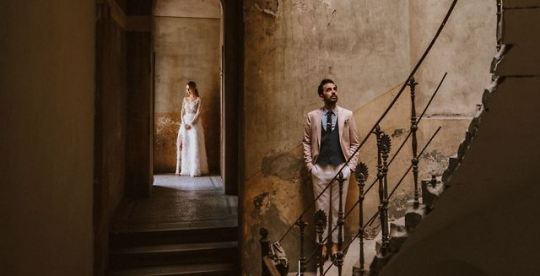





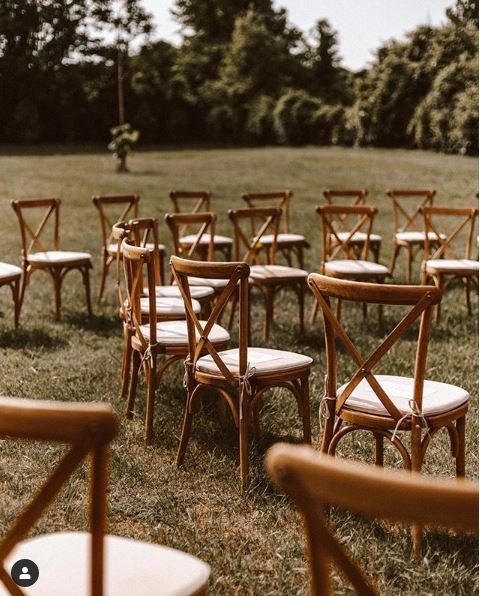

Here are 10 + 1 things I learned while organizing our wedding:
1. Don’t have expectations from people. Especially not the reaction you would like them to have. You are the star of your narrative, but for other people you are just a supporting role.
2. Don’t overshare in the beginning. Keep some secrets and share bits and pieces only when things cannot be altered.
3. It is a myth you cannot organize a wedding in less than half a year. I did it in 2 months, and you can do it too.
4. Making comparisons can spoil your happiness. No two weddings are the same, so don’t be afraid to take an alternative route.
5. You can never be overprepared, so start early and be efficient.
6. Don’t overestimate the superstars. There are a million talented, kind-hearted vendors out there who are not so busy and unattainable as the biggest names in the industry. Rising stars are more eager to work with you than the actual megastars with a million clients.
7. Be a good client. I got a lot of positive feedback about being a “dream client”, which is of course an overstatement, but I firmly believe that the universe gave me this title in exchange for all those years spent working with really sucky people in the creative industry. So…write detailed, but concise and clear briefs and never ever forget to be kind.
8. Early spring can save you a lot of money and headache. Since everyone wants a late spring or summer wedding, all the vendors are booked “in the season” or the ones that are not booked are extremely expensive. However almost all the offers I received contained an “out of season” discount for early spring which was very lucky, as I have always wanted an early spring wedding with lilacs and cherry blossoms in bloom. That is my favourite time of the year.
9. Use the advances of modern technology. It is quite romantic to jot down pieces of information in your Moleskine and put a little heart over the i in the word wedding everywhere. But on the long run your mailbox, Google Docs, Instagram, Pinterest, Word and Excel will be better friends if you want to be efficient.
10. DIY. I have a clear vision for a couple of things I want to have at our wedding e.g. the material of the ring holder, the wedding collar for my dog, the bouquet I am going to throw away. Instead of briefing someone and paying a lot of money to have these done, I will just do/order them myself. Outsource things you cannot do e.g. photography, the cake, a wedding arch etc. but don’t let everything out of your hand.
+1. Try to enjoy the process as much as you can. Do it together with your spouse, but everyone should do the part they are good at. Take mental snapshots of important milestones (and actual photos too). Appreciate this amazing journey you are about to take as a couple. And don’t forget to talk about something else every now and then. :)
***
A little additional background info:
Disclaimer: I have the most wonderful friends and family in the world. I feel extremely lucky to have them in my life.
BUT. :D
Since I started organizing our wedding I realized that people can’t be genuinely happy for each other. They can act like they are, oh my, they can be real Meryl Streeps about it, but I don’t think they truly are, not without an ulterior motive. I am not throwing stones, I probably did the same whenever my friends and relatives were getting married.
Iliza, my favourite female comedian grasps this in a hilarious way in her latest Netflix special, the Elder Millennial. In that she talks about people’s reactions after she told them she got engaged. It is dead on. Just watch it, you will see.
Even when your people try their hardest and ask questions while putting up their best “I’m so happy for you” facade, you still feel a certain undertone. A pulsating little “bore someone else with this” stare or vibration in their voice. Or in some other cases, they are really happy for you and then hit you with a question like: “You are not inviting cousin this and that??? But they will be insulted!”
In spite of it all, I am having the time of my life organizing the shit out of our wedding. I think all of my project management experience, all of our travels around the globe and all of my control freakishness led up to this point: the wedding.
Don’t get me wrong, it is not going to be a big, fat, Hungarian affair. It will be a tasteful, romantic little ceremony in my home town on a little island, in the middle of a lake. There won’t be a party afterwards, because we don’t like wedding parties (at least we have never been to a really good one). The bride and groom cannot spend quality time together and they cannot spend quality time with anyone, because there are at least 50 people around them waiting to be entertained. The food is usually mediocre at its best, the music sucks, some relatives always get drunk and being around them becomes just bloody awkward. And there is the added pressure of “how long it is appropriate to stay”.
We decided to have a more intimate celebration, where we have the time and energy to BE with each other and make it to the hotel afterwards in time for our bedtime. There will be a dinner after the ceremony, with our parents and siblings in a great restaurant (Márga Bisztró on the Szent Donát estate) with the most beautiful view of Lake Balaton I have ever seen. Also, the day after we will have brunch with our closest, most dearest friends at the lake. What could be more perfect than this?
Another thing we are doing different is that we are not asking for presents and money either. We do want people to bring us envelopes, but instead of money, we want them to write kind notes, or pieces of advice for married life, or next week’s winning lottery numbers, or just draw or take a photo of something and give it to us.
All of this of course would not be possible without the help of the most amazing people in the wedding industry. I would like to share a list of our vendors, because we are so extremely happy with them. They are incredibly nice and helpful people with impeccable taste and for a reasonable price in each and every case. Our invitations are currently being prepared by the Fanatic Calligrapher, and she is absolutely amazing. She has just sent the first draft and we are in love with it. Our photographers will be Just Stay Natural, a couple I worship on Instagram. My bouquet and the decor will be created by the incredible Toboz Művek , they are effortless, efficient and extremely kindhearted people, and their works take my breath away. I also ordered a couple of decor accessories from Natural Wedding Decor, they have some beautiful products that perfectly fit into our vision. The cake is from Egy csipet torta, who were the biggest POSITIVE surprise. I was really afraid at the beginning that they have become such superstars that it will be next to impossible to work with them, which was the case with some of the VIP people in the wedding industry. But I was wrong, they are nice, professional and responsive and I cannot wait to taste their cakes and design ours together. We also wanted macarons for a dessert bar and who else would do it better than Chez Dodo. The fingerfood for the ceremony will be provided by an old high school classmate, running a very modern and healthy catering service, Four Bites. David’s outfit will probably come from Massimo Dutti, although that we haven’t decided yet. One thing is for sure though: he is going to wear a high top Supra, because we both heavily dislike traditional “formal” men’s shoes. He will look so rad! We will also have a consultation with Ági of Dimesso about the rings in February, we are so looking forward to that too.
And when it comes to my dress: it will be another dream coming true, as I will be marrying the love of my life in Daalarna Couture. Initially I saved up for it and then David surprised me with it for Christmas. I am so humbled by how lucky we are to have found each other 7 years ago.
I hope I deserve David and our life together.
And I also hope I am not dreaming all of this.
***
The photos are credited individually, but here they are again from top to bottom: Egy Csipet Torta, Just Stay Natural, Chez Dodo, The Fanatic Calligrapher, Toboz Művek, Daalarna Couture, Natural Wedding Decor, Just Stay Natural, Dimesso.
1 note
·
View note
Photo
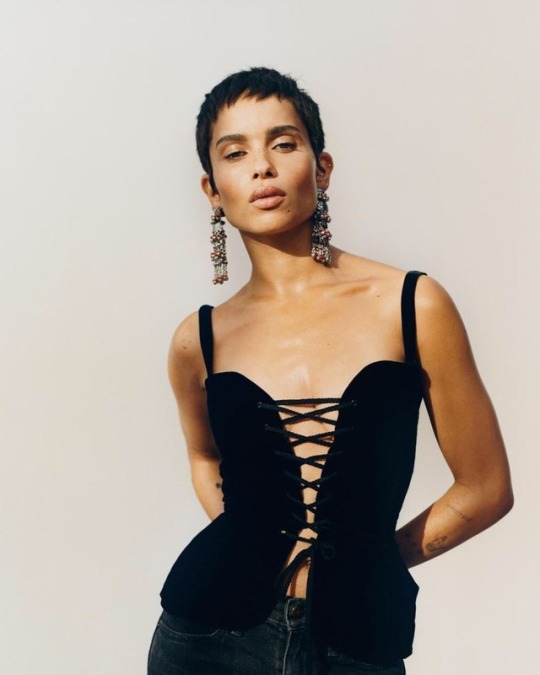

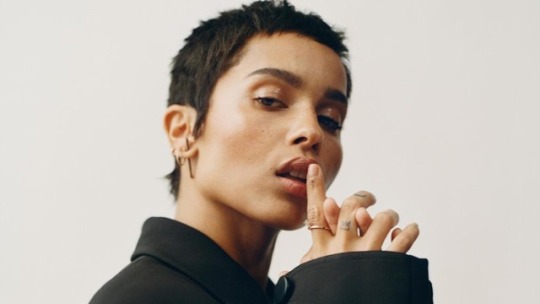

The interview for The Style: Sitting opposite Zoë Kravitz is like looking directly into the sun. On set in Paris, the 29-year-old model-actress-singer is in full promo mode, rattling through all the beautiful products she likes to use on her beautiful face: YSL Beauté Couture Brow on her eyebrows, YSL highlighter over her cheekbones, YSL Touche Eclat around her eyes, though nothing on the cluster of freckles over her nose, which look as if they have been hand-painted by tiny elves. Was there ever going to be another genetic outcome for the only child of Lisa Bonet and Lenny Kravitz, one of the most absurdly good-looking couples of the late 1980s? For a few bright, shining years, they rolled around town dressed up like a pair of fabulous vagabond art teachers: Lenny with his soul patch and polonecks, Lisa in her top hats and micro-sunglasses. In 1987, when they eloped to Las Vegas on Lisa’s 20th birthday, Lenny was still a struggling musician known professionally as Romeo Blue (then later, unofficially, as “Lenny the Loin”), but Lisa was one of the most famous women on the planet, thanks to her role as Denise Huxtable in The Cosby Show. “I guess my mom taught me how to use make-up,” Kravitz says in her surfer-bro drawl. “She wears very light make-up — she would teach me stuff.” She doesn’t flinch when asked about her parents for possibly the thousandth time in her career. In fact, in person she is pretty much exactly what you’d expect if you put Lisa Bonet and Lenny Kravitz in a blender: half bohemian Californian wood nymph, half sassy showman. Kravitz has been acting since her late teens, nailing the box-office hits (X-Men, the Divergent series, Mad Max, Fantastic Beasts), picking some good indies (the critically acclaimed Dope), and most recently starring in the A-list foie gras that was Big Little Lies on HBO. And ever since accompanying her dad on the odd front row as a teenager, it’s the fashion world that has been obsessed with her. She has been signed up for ad campaigns for Coach, Calvin Klein, Alexander Wang and Tiffany, and now she is an ambassador for YSL Beauté. She gets the rigmarole of it all (conversation veers between make-up tips and the benefits of a Trump news diet), but she is engaged and articulate. Minus the occasional slip into LA therapy speak (a lot of talk later about “energy” and “community”). To be fair, she grew up in the patchouli-scented enclave of Venice Beach, before moving to Miami to live with Lenny at the age of 11. Her parents split up when she was two. “It was kind of hard having to go, you know, months without seeing one parent. I actually think it would have been great to be in a situation where you can see someone at the weekend,” she shrugs. “But the grass is always greener, I guess.” Ah yes, the Lenny the Loin years. For a time, there was a revolving door of A-list girlfriends — Vanessa Paradis, Natalie Imbruglia and Kylie Minogue, and brief engagements to Nicole Kidman and Adriana Lima. But there’s no squirming or glibness about it from Kravitz. She is cheerfully self-aware of her parents’ colourful pasts. When a TV host asked what it was like to be reunited with almost-stepmom Kidman on Big Little Lies (“She was always so, so nice to me — I hadn’t seen her since I was 13”), she whooped with delight at the presenter’s suggestion that her father was the perfect rebound after a marriage to Tom Cruise. She has even had a laugh about #penisgate — that moment in an otherwise uneventful (probably?) summer in 2015 when Lenny ruptured his tight-tight leather trousers on stage in Stockholm and momentarily broke the internet. Kravitz uploaded a screenshot to Instagram of a conversation with rocker Steven Tyler’s daughter, Chelsea, and a withering monkey-covering-its-face emoji. Father and daughter are clearly very close: she joined Lenny on tour for a year when she was 13, which sounds like a unique experience for a teenage girl, I say. “It was definitely an experience. I was the only kid [on tour], so, um, being surrounded by nothing but adults as a kid is always kind of a bizarre thing.” In Miami, she attended a top private school, where she was one of the only black girls in her class. She rattles off the memory: “It was pretty hard for me just because, you know, I wasn’t comfortable in my own skin, and I hadn’t found like-minded people, so I felt like a freak.” Meanwhile, the house had drop-in guests including Stevie Wonder, Mick Jagger, Tyler and her godmother, the actress Marisa Tomei. Kravitz and I meet in January, a few weeks after the Golden Globes, when the first wave of Time’s Up activism has kicked into gear. She signed her name on the official petition and wore black in solidarity (strapless Saint Laurent). The elephant in the room is that the projects she will be promoting this autumn both have some pretty clanging #MeToo moments, as both Johnny Depp, her co-star in Fantastic Beasts: The Crimes of Grindelwald, and James Franco, who stars in the indie sci-fi thriller Kin, have faced criticism. How does all this sit with her? Does she feel the need to research people before she says yes to things now? “Of course, but that has always been the case. Now it’s different because we have more information. Like, I didn’t know about A, B and C before, and now I do.” She stops to think. “But I do believe in second chances, depending on who it is — obviously someone like Harvey, no, never again — but you know, there are people who make mistakes and, not that it’s excusable, I don’t want to feel like there’s a separation between men and women.” She sighs. “I don’t know, man, like, I hope that no one is wrongly accused, but a rich white man in America being wrongly accused, welcome to the club. You know how many black and Latino people are wrongly accused and put in jail all the f****** time? So,” she gives a bitter laugh, “that’s life.” Speaking of proper, non-famous life: she has spoken candidly before about her teenage struggles with anorexia and bulimia that lasted well into her twenties. Where is she at now? “I went to therapists, I took all kinds of stuff, but what really made me stop was just being tired of being sick and having this secret, and all of that. It’s exhausting, that need for control or going to throw up, and I felt it in my body.” What does recovery look like for her now? “I definitely still have moments of, ‘Oh my God, I look fat, I gained 4lb.’ I do that to myself and it’s so stressful…” She trails off. “The struggle continues for me. It’s not like I’m completely cured and never think about my weight at all. It’s just about perspective, it’s, like, I want to be happy. Being thin doesn’t make me happy, being hungry doesn’t make me happy, compulsively checking my weight doesn’t make me happy.” So, what does make her happy? “My friends, my family, food makes me happy, that’s the thing, I love cooking so much,” she laughs. “I’m not an organised cook. I have no idea what I’m doing and it’s a mess. My dad was saying the other day, ‘You don’t know what you’re doing, but you put love into the food, and you can tell.’ ” Her parents seem to have nailed the Gwyneth-and-Chris model of post-divorce equanimity: Lenny still describes his ex-wife as his “best friend”. Lisa has been with Game of Thrones actor Jason Momoa since 2007, with whom she has two children. They’re all one big, blended family, appearing on red carpets together and sharing family selfies on Instagram — Lisa and Lenny attended the Met Ball together in 2015. Zoe and Momoa even have matching tattoos, and she named her band, Lolawolf, after her two half-siblings. She now lives with her boyfriend of 18 months, the actor Karl Glusman, who was in Tom Ford’s Nocturnal Animals. Is it the first time she has moved in with a boyfriend? “It’s not. It’s the second time,” she giggles. “It didn’t work out the first time, so…” (That would be with Penn Badgley from Gossip Girl.) “But it’s great.” The couple live in Brooklyn, of course, and hang out with a group of fellow Very Cool Indie Types — Alia Shawkat of Arrested Development/Search Party fame and Ilana Glazer of Broad City are two of Kravitz’s best friends. Filming on Big Little Lies will continue through summer, then she is “leaving things open” after the show. She reclines on the sofa on set and gets going on another good speech: “The whole idea of celebrity is bizarre, but I think what it can do is remind people they’re not alone in the world. You know, being alive is scary, so I just want to be a reflection of another being out there, figuring it out too.” Zoë Kravitz is the make-up face of YSL Beauté
26 notes
·
View notes
Text
thoughts on the beguiled.
I’ve wanted to watch The Beguiled since I saw the trailer for it in 2017, but I never ended up seeing it. I also didn’t hear much hype around it in the 19C US lit academic community, which I was definitely a part of at the time of its release. I saw–I think–a Vogue article on it, and a few articles came out about the costuming or historical setting. It was directed by Sophia Coppola, so that carries some weight–or it should have. I can’t speak much to the film’s popular success, but I can say that it wasn’t a thing in academia. That surprises me now, especially given how popular the recently released Green Knight movie has been in the medieval academic internet. Maybe The Beguiled didn’t get much buzz because it’s a remake, so anyone who would’ve hyped a movie in 2017 had already seen the original, or maybe it’s just that 19C US lit academia hasn’t come to fully appreciate films about that time period (I’m not sure I buy that because everyone had something to say about the most recent Little Women adaptation). Basically, I’m surprised the 2017 The Beguiled wasn’t required viewing for every PhD student in 19C US lit in the same way that literally any single one of the Little Women or Anne of Green Gables adaptations has proven to be. Is it because The Beguiled focuses on the South? Is it because it’s a remake? I don’t know, and now that I’m not in academia, I’m not sure I really care. It’s just a casual thought that prompted this post.
If you haven’t seen or heard of The Beguiled, it’s like Misery meets Little Women but set in the Civil War-era South. The recent adaptation stars Kirsten Dunst, Nicole Kidman, Elle Fanning, and Colin Farrell. The basic premise is that Colin Farrell’s character is a Union (Northern) soldier (originally of Irish descent) who is wounded in battle and hides in the woods to die or … recover? He’s found by a young Southern girl who’s attending an all-girl’s boarding school in the area; she’s out picking mushrooms, finds him, and brings him back to the school so the headmistress can care for him. The five or six other female students at the boarding school–and the headmistress–quickly become enamored with Colin Farrell and begin competing for his affections. They heal his leg, and he begins reciprocating everyone’s attention. He tells Kirsten Dunst he loves her, he shares a few heavy emotion moments with Nicole Kidman, and he flirts repeatedly with Elle Fanning–all while the other girls and women are in the room. It’s bold behavior, but what does he have to lose? Well, actually, a lot because Kirsten Dunst finds him one night in bed with Elle Fanning, and when he approaches her to apologize or explain (honestly, what is his goal????), she pushes him away from her–and down the gigantic plantation house’s stairs. He’s knocked unconscious and his sutured leg injury reopens, so Nicole Kidman decides to amputate because he’s losing a lot of blood (but actually because she’s jealous that he went to Elle Fanning’s bedroom). He awakens from the surgery and is BIG MAD. He calls everyone on their bullshit but also goes into a drunken rage because he only has one leg and the amputation was performed for, frankly, illegitimate reasons. Kirsten Dunst tries to calm him down by having sex with him, but the other women plot how to get rid of him (oh yeah, he grabbed a weapon–I missed how he got it. Did he already have it? I thought Nicole Kidman had one too?), and they decide to have Mushroom Girl go get the bad mushrooms. They feed them to him, he dies, and the leave his body outside the gate for whichever army to pick up as they pass. That’s it. That’s how the movie ends.
I liked this movie; it was fine. Was it what I’d hoped for from Coppola? Not at all. Marie Antoinette is one of my favorite movies and I always how Coppola will make films in that same style. The Virgin Suicides has a lot of that same energy, and I love that film too. The Beguiled definitely feels like a Coppola movie. It has a similar dreamy and ethereal quality, but here there’s a darkness and underlying tension that some of the (literally) brighter films don’t always have–visually, at least. Or, maybe a better way of putting it is that the true bright, dreamy, and ethereal scenes are fewer and further between in The Beguiled than they are in the other two films I mentioned. Whereas the dark, saturated tones appear pretty much throughout in The Beguiled (except in a few very key moments), Marie Antoinette and TVS are dominated by those bright, dreamy, ethereal tones, and the darker, saturated tones appear in very strategic moments to signal Serious Business happening. As a viewer, I don’t mind the difference, but I’m not sure if the dark, saturated tones in The Beguiled always accurately reflect other depths of the film–most notably, its plot. But more on that in a second.
To get the thing out of the way that I’m supposed to talk about as someone with a PhD in 19C US lit, the historical stuff in this film works. It’s not trying to be irreverent or fanciful with historical tropes like, say, Marie Antoinette. That’s not a value judgment; it’s just a comment. Frankly, I don’t really have too much to say about this film’s historical aspects. Whereas I usually have some opinion of costuming (the recent Little Women adaptation is wonderful but there are … things I don’t love) or how historical subject matter from the period gets treated in films, in this case, I really wasn’t distracted by any significant historical inaccuracies and there were only a few times that I was like “wait a second, is this right???” Honestly, the biggest cause for that question related to some of the evening wear, which looked a little cheap, but that’s whatever; also, Civil War-era garments aren’t something I know especially well, so who am I to judge?
I appreciated the film’s take on women’s–well, some women’s–concerns during the Civil War, including the threats posed by roving military troops on both sides of the conflict, the loss of loved ones (and the sense that their lives are halted but also must go on), the mindless regurgitation of stereotypes about enemy soldiers, etc. I also love the way the film portrays some of the more mundane aspects of these women’s lives–the monotony of sewing, housework, and learning French to speak … with one another–and some of the unique situations caused by wartime population changes, including middle- and upper-class women’s need to perform outdoor labor (I was surprised to see them using shovels, for instance).
I was, frankly, extraordinarily disappointed to see that the film pares the household economy down to a group of middle- and upper-class white women with a casual comment about how all of the enslaved workers left prior to the film’s opening. I understand that this detail further emphasizes how alone and isolated this group is, but for a film released in 2017, it frankly felt like a cop-out. It’s unfathomable to me that a Southern Gothic film set during the Civil War wouldn’t have one single Black character and could write an entire population off in a throw-away line at the beginning of the film. Black Americans played essential roles in the US economy during this period–in all periods, but I’m talking about this one specifically here–and they were pivotal figures in the Civil War itself. They held especially pivotal roles in the South’s (really, the nation’s) economy, and their relationships with domestic life in that region were so complex, rich, and, frankly, worthy of all the attention in the world. Did the film’s producers not want to hire more actors, or did they think a group of white people having old-timey white people problems was enough to bring in audiences? The 19C was full of a million different stories of how enslaved southerners responded to the war and how their lives changed–especially in the South–because of it, so to not depict even one of those stories strikes me as … well, representative of what’s wrong with this film.
Okay, so I lied when I said I didn’t have an opinion on the historical stuff in this film.
My big issue with the film–well, other than (or connected with) the fact that it completely ignores literally the most important population of society during the historical moment it depicts–is that this film’s content doesn’t seem to live up to its visual richness and depth. What I mean by this is that the film’s deep and rich visual style–the color saturation and tones mentioned above–don’t mesh with the plot and characters, which are collectively underdeveloped. I think the underdeveloped plot is fairly straightforward–I didn’t need to leave much out in my summary above, and that paragraph is shorter than most emails I send. This is a film without subplots, which has made me realize how important subplots actually are for fleshing out a fictional world–even a fictional world I know a lot about and am able to imagine my own depth for. The story is a love triangle (with a few extras) in the South during the Civil War. That love triangle could take place literally anywhere and anytime else and it’d have basically the same tension. I’m not even sure you really even need the enemy soldier dimension of Colin Farrell’s character because it’s barely an issue; the majority of the tension comes from the threat a man poses–even an injured one–to a group of women, and that’s timeless. We, as a society, are also obsessed with the idea of women fighting for a man, a storyline I’m getting a bit sick of because it’s just another way we pit women against one another. But that gets to something else, which is the lack of character development. The characters–all seven of them or whatever–are stereotypes. Kirsten Dunst is the shy one who underestimates her beauty, Colin Farrell is an undercover Casanova (a 19C fuckboy, shall we say?), Elle Fanning is a flirt, and Nicole Kidman is a stern (and vindictive) older unmarried woman. We also have the spoiled rich girl and the silly sweet (but also unexpectedly vicious) girl. And Mushroom Girl is the nature-lover, who we know will be expected to conform to societal expectations the second the war ends and she reaches a certain age.
Frankly, the most interesting part about this film is imagining what is happening and will happen outside of what it shows on screen. I spent the entire time I was watching it wondering what these girls’ families were doing, how the soldiers just beyond the camera shots were faring, what the home’s previous (enslaved) domestic laborers were up to and where they had gone (and what their lives were like here before the war), what would happen to the girls in the days and months following the events of the film, etc.
TL;DR: It’s a flawed film that wasn’t terrible to watch, but left me wanting more–a lot more, and not in a “oh, make a sequel!” kind of way but in a “what was left on the editing room’s floor?” kind of way.
xoxo, you know.
1 note
·
View note
Text
The Prom: Ranking Every Song in the Movie Musical Soundtrack From Worst to Best
https://ift.tt/3mbeEmh
The 2018 Broadway musical The Prom has always had a somewhat shaky premise, combining a quartet of narcissistic Broadway stars (Meryl Streep, James Corden, Nicole Kidman, and Andrew Rannells) looking for a way to be relevant again with a lesbian couple’s (Jo Ellen Pellman and Ariana DeBose) simple wish to attend their prom in Edgewater, Indiana. The two threads collide when the prom gets blown up into a civil rights issue. However, the stage show reconciled these seemingly disparate elements into a heartwarming tale of self-acceptance for all involved: straight or gay, closeted or out, aging star or varsity cheerleader.
Ryan Murphy’s film adaptation for Netflix, by contrast, is less successful. The awkward space between these two stories is more pronounced, with the Broadway portions plagued by puzzling lighting and editing choices. Combine that with some truly head-scratching casting among three of the four adults, and it distracts from the intent of basically half the soundtrack.
However, when it comes to all things prom-related, the adaptation is nearly as strong as its Broadway predecessor, and in some places utilizes cinematic elements to surpass the original versions of key musical numbers. With that in mind, we’re ranking all 19 songs from worst to best, keeping in mind that the rankings would likely have turned out differently had we been considering the musical itself.
19. Barry is Going to Prom
James Corden was disastrously miscast as gay actor Barry, who removed himself from his parents’ lives as a teenager before they could cast him out, yet is still clearly in need of closure. One can never shake the feeling of watching this straight actor put on queer identity as an ill-fitting suit; there’s more than one “did I just hear that right?” moment of him lisping his way through a scene.
He brings that disingenuously effeminate energy to Barry’s big number, “Barry is Going to Prom,” and tarnishes what should be a triumphant showstopper. Not surprisingly, Corden in a silver-and-aqua tux mincing through a fantasy sequence is so much less compelling than original star Brooks Ashmanskas belting in his pajamas.
18. Simply Love
The second of the two end credits songs seems to be a rejected number for Barry’s reunion with his estranged mother while also advocating for Emma. Despite the feeling Corden tries to infuse into it, emotionally it’s empty. The only thing saving it from rock bottom on this list is that there are no accompanying visuals.
17. The Acceptance Song
The first sign that the Broadway crew have overestimated their star power is when their big “rally” in Emma’s honor gets booked… at the halftime show of the local monster truck rally. They try to sing a song about acceptance, but neither they nor the monster truck enthusiasts are equipped to give or receive the message. It’s a forgettable song, but that’s kind of the point, isn’t it?
16. Wear Your Crown
The first end credits song is so overproduced that I had to look up who sang it—turns out it’s the entire cast, their voices blended into one unnatural warble. The only thing that saves it is that they do the musical credits thing where they match the names with the performances (here, it’s them posing at the prom with superlatives), so you can remember who you did or didn’t like all over again.
15. Zazz
As solo numbers go, this is not Nicole Kidman’s best; but then again, can anything really top Moulin Rouge!? Perennial chorus girl Angie’s ode to making yourself a star is meant to evoke Bob Fosse and Chicago, but winds up resembling a mere shadow of that brilliance. And, unlike how Kidman breaks our hearts with “Come What May,” this ditty could have been sung by anyone.
14. Changing Lives
As opening numbers go, this one doesn’t rank very high, in part because it has to do so much heavy lifting for the less obvious half of The Prom’s premise: Dee Dee (Meryl Streep, unconvincing at the start) and Barry watch their Eleanor Roosevelt musical close on opening night because they are too self-involved to authentically inhabit these historical figures.
Scrolling Twitter’s trending topics for a “cause” that will reverse their PR disaster, they find Emma and automatically decide that they can and will change her small-town baby gay life. With all that exposition, the song’s actual message—that actors and art can change people’s lives—gets lost. What is fun is intercutting the post-show glow with footage of Dee Dee and Barry in costume as Eleanor and FDR on-stage in what feels like a parody of Hamilton.
13. It’s Not About Me
This is a peppier, more on-the-nose version of “Changing Lives,” yet it strikes a bunch of discordant notes, like Dee Dee and co. sweeping into the PTA meeting to rally for Emma but really turn the spotlight on themselves. It’s too much cringe, too early in the story; and worst of all, Streep simply doesn’t seem to be having fun. Instead she looks like she has to force this number out to get on to the more compelling stuff.
12. Changing Lives (Reprise)
The reprise ranks higher than its predecessor because there’s just enough of an ironic twist to signal to the audience that we’re immediately poking fun at these self-obsessed Broadway stars. The line “We’re gonna help that little lesbian / Whether she likes it or not” is unexpectedly hilarious, though the CGI Times Square backdrop is tough to swallow.
11. We Look to You
Perhaps it’s not surprising that all of the songs about the saving power of art are clumped in the same section of the ranking. Perhaps that element of the show translated better to the literal stage, but in the movie these sequences are garish and don’t fit alongside the sweet, straightforward conflict that Emma and Alyssa face.
Read more
Movies
Best Meryl Streep Musical Performances (Including The Prom!)
By David Crow
Movies
Best Movie Musicals of the 21st Century
By David Crow
This number does try to bridge that divide, however, with Keegan-Michael Key’s straight ally Principal Hawkins tenderly serenading Dee Dee with memories of her performing. Yet through no fault of his own, they still seem an oddly matched pair, which dampens the romantic effect of the song.
10. Unruly Heart
As Emma’s big number, delivered via humble strumming on YouTube that goes viral by tugging the heartstrings of LGBTQ teens everywhere, “Unruly Heart” felt as if it should have ranked higher. There’s a fun effect of Emma’s bed spinning, making the confines of her room seem bigger as her message spreads to millions of people; it also looks like something out of a Broadway show. But one is left with the feeling that this should be a tearjerker for where it exists in the story. This is likely the biggest casualty of the stage-to-screen adaptation.
9. The Lady’s Improving
This is Streep in her musical element, bringing to mind a mix of the whimsy of “Money, Money, Money” and the yearning of “Mamma Mia.” It’s also got that sharp cleverness that’s all too rare in the Broadway portion of this story, with Dee Dee resurrecting her starring role for a one-afternoon-only, private performance for Hawkins. Wouldn’t you know it, this unapologetic preying on his nostalgic fandom for a fictional character is what actually sells their oddball relationship.
8. Alyssa Greene
DeBose’s bitter defense of staying in the closet starts out as the seemingly low-stakes complaints of a straight-A student afraid to step out of line. But as Alyssa’s refrains keep returning to her mother (Kerry Washington)—complete with flashbacks of earnest Washington playing the helicopter-mom to a tee—it becomes achingly clear just how committed Mrs. Greene is to making her daughter’s life not be “difficult,” at least by her metrics. It’s also clear how much Alyssa feels she owes her.
Read more
Movies
Best 11 Classic Movie Musicals
By David Crow
Movies
Hamilton Cast Reflect on Backlash and Criticism of Musical
By David Crow
The best part is that this impassioned “I wish” song is not enough to win back Emma’s trust, and actually leads to their breakup instead. Emotional vulnerability, met with stakes-raising conflict! We love to see it.
7. It’s Time to Dance
Sure, it’s the triumphant final number, but it’s also so much spectacle (mostly with the ensemble’s too-cool-for-school dancing) that it’s difficult to focus on the emotional underpinnings. Reprisals of motifs like “Dance with You” (look ahead) and “Unruly Heart” buoy it up, and of course so does Emma and Alyssa’s big kiss. But this feels like the big shiny denouement as opposed to the less polished but more poignant songs that will stick with you longer.
6. Tonight Belongs to You (Reprise)
Just as “Changing Lives (Reprise)” recontextualizes its predecessor, the reprise of “Tonight Belongs to You” twists the knife: After being humiliated by the school-wide prank of the fake prom, Emma tortures herself with one last reminder that tonight was always about the “normal” kids. It’s the heartbreaking complement to her stalwart sense of self in “Just Breathe” (see below), with Emma confronting the truth that even if she loves herself, her peers and their parents don’t.
5. Love Thy Neighbor
Without a doubt, Rannells makes this song more charming than it has any right to be. You couldn’t have found a better choice than the Book of Mormon alum to point out the hypocrisy in cherry-picking which religious rules to follow. And unlike a lot of The Prom’s other attempts to shoehorn Broadway culture into this small town, the Godspell vibe of “Love Thy Neighbor” expertly gets through to these closed-minded classmates. If Rannells were teaching drama and the Bible to teens like this, it’d go a long way toward bridging that empathy gap.
4. Just Breathe
Pellman is earnestly wonderful even in songs that are duds, but this is the perfect introduction. “Note to self: Don’t be gay in Indiana” tells you everything you need to know about how lovely Emma is: wry and self-assured, secure in both her own identity and in who she loves, even if she has to protect that secret for Alyssa.
Read more
Culture
How Disney Saved Musicals for a New Generation
By David Crow
Movies
The Top 25 Best Disney Songs from the Renaissance Era
By David Crow and 1 other
Yet this inner monologue of a song is relatable to all adolescents who don’t quite fit into high school’s damning constraints, a keen reminder to just breathe and move past the moment, looking ahead to a place or hopefully someday a world in which they won’t be the odd person out.
3. You Happened
This bubbly number seemingly shouldn’t rank so high in the list, yet it’s the most authentic aspect of the story it’s depicting: Teenagers acting out the epic love stories they’ve seen in film and yes, on the stage, playacting at adult declarations of devotion.
Read more
Movies
Happiest Season: The Problem With Harper’s Treatment of Abby and Riley
By Delia Harrington
Movies
New Netflix Christmas Movies in 2020 Ranked from Best to Worst
By Delia Harrington
It’s the classic promposal that teens have swooned over from Laguna Beach to TikTok, but one-upped through boy-band choreography and a built-in chorus of high schoolers crooning “Youuuu happened!” like it’s the big love confession from When Harry Met Sally. Yet these over-the-top promposals don’t hold a candle to…
2. Dance with You
Emma and Alyssa’s sweet anthem has the sweeping strains of a classic love song—old-Hollywood romance that reflects their simple wish to not be symbols of a movement, but to get the same quintessential high school experience as their straight classmates. It’s also one that benefits from the movie expanding the scope of a song, with the young lovers walking hand-in-hand through their empty school and waltzing under ethereally lit pink trees. Every time the motif recurs in later songs (hitting different notes each time), it conjures that same swell of emotion.
1. Tonight Belongs to You
The fact that this song attained number-one despite Corden’s bad performance overshadowing the first verses is a testament to its infectious joy, and to the frankly incredible layers of emotion contained within.
Beneath the giddy veneer of getting ready for prom, there are so many darker aspects: Barry strong-arming poor Emma into a femme makeover in an attempt to live vicariously through the prom he never had. Cheerleaders Shelby and Kaylee singing “One thing’s universal / Life’s no dress rehearsal” as they step into identical limos in their cookie-cutter cul de sac, as if they could ever fathom an experience outside of their own. This entire song claims that the night is about Emma, but it’s about everyone but her, and that is so uncomfortably truthful.
And then… the moment Emma steps into the gym to find that the entire school played a cruel trick on her. Her peers singing as if they’re in the same boat as her, as they sail on to their real prom, leaving her the humiliation of entering the empty school gym, encapsulates the brutality of high school in a single song. They’ve turned the supposedly empowering Act I finale into the ultimate villain song. The Prom is uneven overall, but as enduring musical songs go, “Tonight Belongs to You” takes the crown.
But as with all things prom, every vote counts. How would you rank the songs from Netflix’s The Prom?
The Prom is now streaming on Netflix.
cnx.cmd.push(function() { cnx({ playerId: "106e33c0-3911-473c-b599-b1426db57530", }).render("0270c398a82f44f49c23c16122516796"); });
The post The Prom: Ranking Every Song in the Movie Musical Soundtrack From Worst to Best appeared first on Den of Geek.
from Den of Geek https://ift.tt/3mdb2Ac
1 note
·
View note